- Asia - Pacific
- Middle East - Africa
- Apologetics
- Benedict XVI
- Catholic Links
- Church Fathers
- Life & Family
- Liturgical Calendar
- Pope Francis
- CNA Newsletter
- Editors Service About Us Advertise Privacy


St. Martin of Tours Feast day: Nov 11
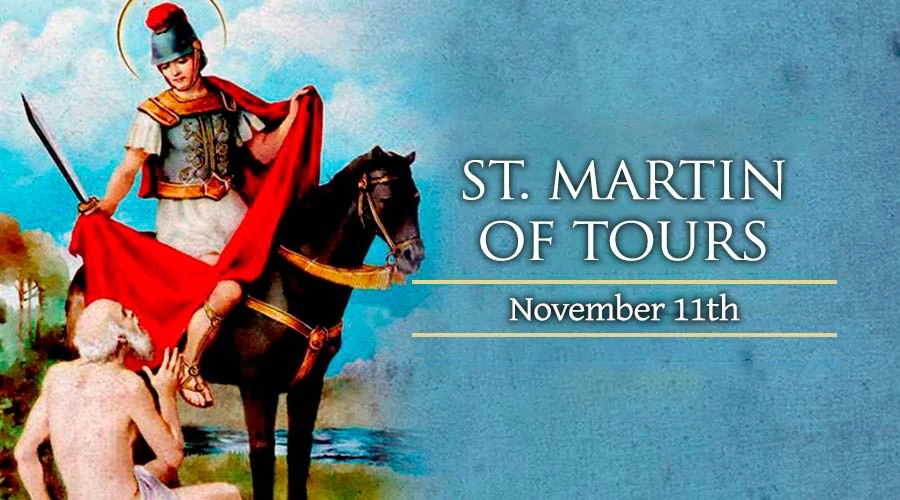
On Nov. 11, the Catholic Church honors St. Martin of Tours, who left his post in the Roman army to become a “soldier of Christ” as a monk and later bishop.
Martin was born around the year 316 in modern-day Hungary. His family left that region for Italy when his father, a military official of the Roman Empire, had to transfer there. Martin's parents were pagans, but he felt an attraction to the Catholic faith which had become legal throughout the empire in 313. He received religious instruction at age 10, and even considered becoming a hermit in the desert.
Circumstances, however, forced him to join the Roman army at age 15, when he had not even received baptism. Martin strove to live a humble and upright life in the military, giving away much of his pay to the poor. His generosity led to a life-changing incident, when he encountered a man freezing without warm clothing near a gate at the city of Amiens in Gaul.
As his fellow soldiers passed by the man, Martin stopped and cut his own cloak into two halves with his sword, giving one half to the freezing beggar. That night, the unbaptized soldier saw Christ in a dream, wearing the half-cloak he had given to the poor man. Jesus declared: “Martin, a catechumen, has clothed me with this garment.”
Martin knew that the time for him to join the Church had arrived. He remained in the army for two years after his baptism, but desired to give his life to God more fully that the profession would allow. But when he finally asked for permission to leave the Roman army, during an invasion by the Germans, Martin was accused of cowardice.
He responded by offering to stand before the enemy forces unarmed. “In the name of the Lord Jesus, and protected not by a helmet and buckler, but by the sign of the cross, I will thrust myself into the thickest squadrons of the enemy without fear.” But this display of faith became unnecessary when the Germans sought peace instead, and Martin received his discharge.
After living as a Catholic for some time, Martin traveled to meet Bishop Hilary of Poitiers, a skilled theologian and later canonized saint. Martin's dedication to the faith impressed the bishop, who asked the former soldier to return to his diocese after he had undertaken a journey back to Hungary to visit his parents. While there, Martin persuaded his mother, though not his father, to join the Church.
In the meantime, however, Hilary had provoked the anger of the Arians, a group that denied Jesus was God. This resulted in the bishop's banishment, so that Martin could not return to his diocese as intended. Instead Martin spent some time living a life of severe asceticism, which almost resulted in his death. The two met up again in 360, when Hilary's banishment from Poitiers ended.
After their reunion Hilary granted Martin a piece of land to build what may have been the first monastery in the region of Gaul. During the resulting decade as a monk, Martin became renowned for raising two people from the dead through his prayers. This evidence of his holiness led to his appointment as the third Bishop of Tours in the middle of present-day France.
Martin had not wanted to become a bishop, and had actually been tricked into leaving his monastery in the first place by those who wanted him the lead the local church. Once appointed, he continued to live as a monk, dressing plainly and owning no personal possessions. In this same spirit of sacrifice, he traveled throughout his diocese, from which he is said to have driven out pagan practices.
Both the Church and the Roman Empire passed through a time of upheaval during Martin's time as bishop. Priscillianism, a heresy involving salvation through a system of secret knowledge, caused such serious problems in Spain and Gaul that civil authorities sentenced the heretics to death. But Martin, along with the Pope and St. Ambrose of Milan, opposed this death sentence for the Priscillianists.
Even in old age, Martin continued to live an austere life focused on the care of souls. His disciple and biographer, St. Sulpicius Severus, noted that the bishop helped all people with their moral, intellectual and spiritual problems. He also helped many laypersons discover their calling to the consecrated life of poverty, chastity and obedience.
Martin foresaw his own death and told his disciples of it. But when his last illness came upon him during a pastoral journey, the bishop felt uncertain about leaving his people.
“Lord, if I am still necessary to thy people, I refuse no labour. Thy holy will be done,” he prayed. He developed a fever, but did not sleep, passing his last several nights in the presence of God in prayer.
“Allow me, my brethren, to look rather towards heaven than upon the earth, that my soul may be directed to take its flight to the Lord to whom it is going,” he told his followers, shortly before he died in November of 397.
St. Martin of Tours has historically been among the most beloved saints in the history of Europe. In a 2007 Angelus address, Pope Benedict XVI expressed his hope “that all Christians may be like St Martin, generous witnesses of the Gospel of love and tireless builders of jointly responsible sharing.”
Latest news

Harris pushes child tax credit expansion at rally days after Vance makes similar proposal

870 attacks against the Catholic Church reported in Nicaragua since 2018

Haitian priest says conditions in country are ‘unacceptable, intolerable, and inconceivable’

Irish authorities investigating stabbing of Catholic chaplain as possible terror incident

Louisiana treasurer urges ban on Bank of America over alleged religious discrimination

Rupnik art appears on Vatican website again — and in Pope Francis’ apartment

New Zealand Church’s safeguarding efforts praised, but report highlights need for action

Immigrant priests, New Jersey diocese sue U.S. State Department over visa delays

Pakistan: One year later, Jaranwala Christians await justice

Vatican talks to China in continued Russia-Ukraine peace efforts
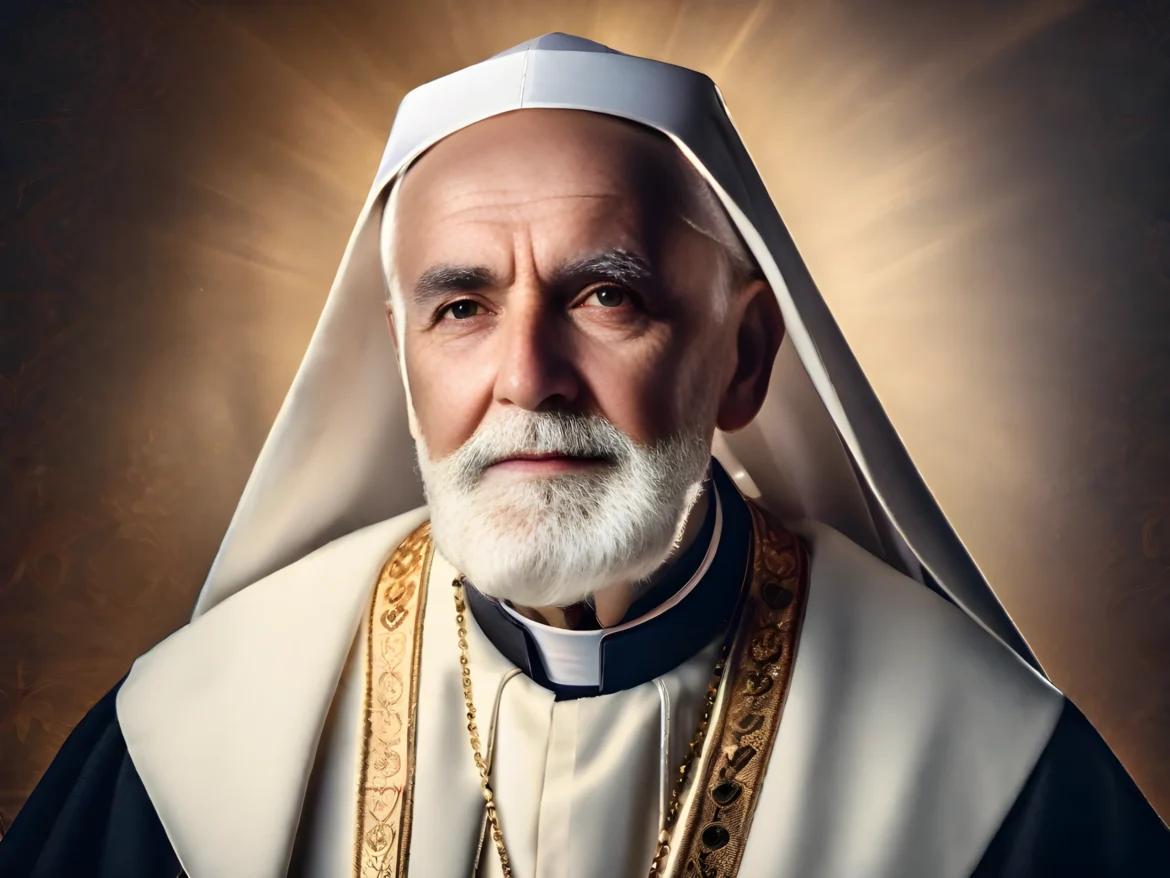
- Martin of Tours: A Beacon of Faith and Humility
There is something profoundly captivating about the life of St. Martin of Tours. His story, a testimony of sacrificing one's own comfort for the sake of others, instills a sense of awe even today. Nestled within the folds of time, there awaits an anecdote from his life that I often reflect upon. On a bitterly cold winter day , a near-naked beggar was shivering in the freezing cold. Martin, moved by the man's plight, took his own cloak, tore it in two, and covered the beggar to protect him from the cold. That night, he dreamt of Jesus wearing the same piece of his cloak, thanking him for his compassion and charity. This act of kindness, the selfless sharing of his cloak, marks one of the significant events of Martin's life.
Table of Contents
The Early Life of St. Martin of Tours
Born in the year 316 AD, in what is now Hungary, Martin has been a symbol of faith, humility, and dedication. Despite his father's wishes to join the Roman army, Martin found himself more inclined towards Christianity and the Church. His entry into the Christian religion was not immediate, but once he devoted himself, he did so wholeheartedly.
Martin’s Journey Towards Spirituality
Martin of Tours had a spiritual awakening in Amiens, where he served in the Roman army. The incident with the beggar sparked the flame of spirituality within him. After this transformational experience, Martin left the military to serve God and spread the message of love and charity. He embraced monastic life and became a disciple of St. Hilarius in Poitiers.
Martin as a Monk and Hermit
Leading a life of austerity and spiritual rigor, St. Martin developed a deep understanding of the Holy Scriptures. He lived as a hermit for a while, inspiring many others by his example. His reputation as a holy man led to his appointment as the Bishop of Tours.
Martin as the Bishop of Tours
Despite his reluctance to assume the role, Martin's appointment as the Bishop did not change his monastic lifestyle. He continued to live simply and humbly, setting an example for both clergy and laypeople. As a bishop, his life was marked by miracles and acts of charity.
Miracles Associated with Martin of Tours
Several miracles are attributed to St. Martin, including resurrections and healings, which consolidated his reputation as a saint during his lifetime. His fame transcended boundaries, attracting people from afar seeking spiritual guidance and healings.
Martin’s Legacy
More than 1700 years after his death, St. Martin's spirit lives on. His legacy continues to inspire countless individuals around the world, reminding them of the transformative power of faith, humility, and charity. It serves as a reminder that our actions, founded in love, can touch the heart of God.
"Heavenly Father, as we recall the selfless love and humility of your faithful servant, St. Martin of Tours, may we be inspired to live according to your will. May we become true ambassadors of your love and mercy. We ask this through Christ, our Lord. Amen."
May the life of St. Martin of Tours embolden us all to imitate his virtues. As we remember him, let's pray that his teachings would resonate in our hearts, illuminating our path, and leading us ever closer to our Heavenly Father.
In the vast ocean of saints, Martin of Tours emerges as a guiding star, showing us the way to navigate the tumultuous waters of life with courage, conviction, and love. The echo of his acts of charity and humility reverberates across centuries, enveloping believers with warmth and hope.
Remembering St. Martin, we are reminded that greatness lies not in worldly achievements but in humble acts of kindness. As members of the Catholic faith, may we strive to live by his example, loving and serving those around us, no matter how insignificant our actions may seem.
Who knew that the simple act of sharing a cloak could write an unforgettable chapter in the annals of Christianity? Perhaps, it's the smallest acts of love that leave the most significant imprints on the sands of time.
Remember, Martin of Tours demonstrates that the path to sanctity is paved with small acts of love and sacrifice. Let's take this message to heart and strive to live a life worthy of our calling.
St. Frances Xavier Cabrini HD

LIVE | Race - PART 2 | CrowdStrike 24 hours of Spa - Fanatec GT World Challenge powered by AWS

St. Margaret of Scotland HD

What was Saint Martin of Tours known for?
Saint Martin of Tours is a renowned figure in the Catholic Church known for more than one reason. Born around 316 AD in Hungary, he is often associated with the military as he was conscripted into the Roman army. However, he is most recognized for an incident where he cut his cloak in half to share with a beggar during a snowstorm . His act of charity is widely commemorated, symbolizing his profound compassion for the poor and the destitute.
Later, he had a dream where Jesus revealed Himself wearing the half-cloak Martin had shared. This vision prompted him to be baptized and abandon his military career. Martin sought a monastic life and became a disciple of St. Hilary of Poitiers, leading to the founding of the first monastery in Gaul (now France) .
Eventually, Martin became the Bishop of Tours. Notably, he was one of the first bishops to be elected by the people, rather than by church officials or imperial authority. As a bishop, he continued to live monastically, focusing on evangelism, raising other monasteries, and confronting Arianism, a heretical doctrine that denied Christ's divinity.
St. Martin of Tours died on November 8, 397. His legacy lives on in his feast day, November 11, celebrated in many parts of the Christian world. He is the patron saint of soldiers, horses, riders, geese, and vintners, among other things, due to various legends and tales associated with him.
What were the miracles of Martin of Tours?
Saint Martin of Tours was one of the most recognized saints in the Western Christianity who lived in the 4th century. The miracles attributed to him were recorded in the "Vita S. Martini" ('Life of Saint Martin') by Sulpicius Severus.
The Miracle of the Pine Tree: St. Martin is said to have brought down a Pine tree that was used for pagan worship, despite the protests of the local people. He declared his faith in God and offered to stand in the path of the falling tree. As the tree was cut down, it miraculously fell in the opposite direction, thus sparing him.
The Raising of the Catechumen: In the second miracle, a young catechumen (a Christian being instructed in the faith but not yet baptized) fell ill and died. Upon hearing the news, St. Martin visited the deceased body, lay upon it, and prayed fervently. Suddenly, the young man's body began to show signs of life, and he was revived, thus showcasing a resurrection miracle.
The Miracle of the Fire: When a massive fire broke out at a place where St. Martin was staying, he confronted the raging inferno without any fear, praying fiercely and marking the sign of the cross. Astonishingly, the fire subsided, and no harm came to anyone present or the surrounding buildings.
These accounts of miracles attributed to Saint Martin of Tours have served to represent his virtue, faith, and power as a miracle worker in the eyes of the Catholic Church.
What is a famous quote from St Martin of Tours?
St. Martin of Tours is a beloved Catholic saint with numerous quotes attributed to him. One of his most notable quotes is:
" Hitherto, I have served you as a soldier; let me now serve Christ. Give the bounty to these others who are going forth to fight, but I am a soldier of Christ and it is not lawful for me to fight. "
This quote reflects St. Martin's decision to leave his military service and devote his life to Christ. This pivotal moment clearly demonstrates St. Martin’s commitment to his faith and his readiness to serve in the name of peace, even at the cost of his own personal safety and status.
Why is St Martin of Tours a saint?
St. Martin of Tours is regarded as a saint for various significant reasons.
Firstly, he was one of the first known conscientious objectors , opting to serve in a non-combat role during his time in the Roman army. His decision was based not on fear of battle, but by his faith and belief that his Christian beliefs were incompatible with military service.
Secondly, St. Martin is celebrated for his spirit of charity and kindness . The most famous legend attached to him is the account of him using his military sword to cut his cloak in half, to give part to a beggar clad only in rags in the depth of winter. This act of charity illustrates his selfless desire to help others.
Lastly, St. Martin was instrumental in spreading Christianity in rural Gaul (modern-day France) , which was largely pagan at the time. He established monasteries and promoted education, playing a crucial role in the advancement and spread of the Christian faith.
St. Martin's piety, goodwill, and efforts to propagate Christianity are the main reasons why he is adored as a saint in the Catholic Church. His feast day is observed on November 11.
Who was Martin of Tours and what is his significance in the Catholic church?
Martin of Tours was a bishop in the fourth century who is regarded as one of the most significant figures in the development of Western Christianity. He was born around 316 AD in Szombathely, Hungary to pagan parents. At a young age, Martin felt a call to Christianity and eventually became a catechumen (someone receiving instruction in the Christian faith).
His life took a significant turn when he had a vision of Christ appearing to him as a beggar. This triggered his full conversion to Christianity and led to one of the most famous anecdotes about his life. When approached by a half-naked beggar asking for alms in the middle of winter, Martin famously cut his military cloak in half to share with the man. That night, he dreamt of Jesus wearing the half-cloak, confirming his decision to follow Christ wholeheartedly.
Martin eventually left the military to become a disciple of Saint Hilary of Poitiers, and later founded a monastic community at Ligugé, France - the first monastery in Gaul. He was reluctantly ordained as Bishop of Tours in 372 AD, where he vigorously propagated Christianity across Western Europe.
Martin’s significance in the Catholic Church is manifold. He stands as a model of Christian charity, represented by the act of sharing his cloak with the beggar. His establishment of the monastery paved the way for the spread of monasticism in the West. Moreover, Martin strongly opposed Arianism, a controversial theological topic in the early church, resulting in his role as a defender of orthodoxy.
Most importantly, Martin of Tours is recognized for extending the concept of sanctity beyond the martyrdom. As a confessor saint who had not died as a martyr, he began a new trend in the veneration of saints.
The Feast of Saint Martin of Tours is celebrated annually on November 11, often marking the beginning of winter and the advent season. This reflects his enduring legacy within the Catholic tradition.
What miracles are attributed to Saint Martin of Tours?
Saint Martin of Tours, one of the most familiar and recognizable Christian saints in the Western tradition, is credited with numerous miracles. The miracles attributed to him are often tied to his profound humility, kindness, and faith.
1. The Miracle of the Cloak: This is probably the most famous miracle associated with Saint Martin of Tours. According to legend, while Martin was still a soldier in the Roman army, he encountered a poorly dressed beggar during a cold winter. Despite not having much himself, Martin cut his soldier's cloak in half with his sword, giving one half to the beggar. That night, Martin dreamt of Jesus Christ wearing the half-cloak he had given away, signifying his service to Christ in the poor.
2. Resurrection Miracles: There are many accounts where Martin brought people back from the dead. One account involves a catechumen (a Christian convert under instruction before baptism) who died without being baptized. Martin laid on top of the deceased and prayed. After two hours, the man came back to life.
3. Healing the Sick: Many miracles of healing are also ascribed to Saint Martin. In one case, he is said to have healed the diseased eye of Saint Paulinus of Nola. In another account, he cured an entire island of people from diseased conditions after they converted to Christianity.
4. Exorcism: Martin was also known for performing exorcisms. There's a tale that says he once confronted a pagan temple, where he was challenged by a tree - a symbol of a pagan god. A demonically possessed man was brought forward, and Martin commanded the demon to vacate the man's body.
5. Control over Nature: Several miracles reflect Martin's supposed control over the elements. It's believed he once redirected a boulder threatening to crush a church. On another occasion, it was reported that he caused a drought-ending rainstorm on a parched region.
Remember, these miracles, passed down through oral tradition and later written records, serve to highlight Saint Martin's saintly virtues and God's power working through him. For some, these miracles are accepted as faith's mysteries, while skeptics may view them as allegorical or symbolic narratives.
How did Martin of Tours become a saint in the Catholic Church?
Martin of Tours became a saint in the Catholic Church through a series of notable events and decisions in his life that exemplified Christian virtues, leading to his canonization after his death.
Born in modern-day Hungary in 316 AD, Martin was conscripted into the Roman army at a young age. One winter day, Martin famously encountered a shivering beggar whom he clothed using part of his own military cape. That night, he dreamt of Jesus wearing the piece of the cloak he had given away, which prompted his baptism into Christianity.
Eventually, he left the military to live a monastic life. He is known as the founder of monasticism in France . He was later coerced by the people of Tours to become their bishop. As a bishop, he continued his simple and austere lifestyle by living in a cell attached to his church. He was known for his commitment to the poor, his miracles, and his gift for evangelizing.
Upon his death on November 8, 397, Martin's acclaim was almost immediate--despite canonization processes not being formalized until the 12th century. His successor in the bishopric of Tours, Gregory, wrote extensively about Martin. Gregory’s writings about Martin's miracles and holiness played a significant role in spreading Martin's reputation. The veneration of Martin spread throughout the whole Church very swiftly.
By the Middle Ages, Martin of Tours was one of the most popular saints in the Church, especially among the Frankish (French) peoples. His feast day, Martinmas, became associated with many customs across Europe. Martin was eventually canonized as a saint in the Catholic Church for his charity, his dedication to God, and his commitment to monastic and evangelical life.
What lessons can we learn from the life and works of Saint Martin of Tours?
Saint Martin of Tours lived a life of dedication to the service of God and humanity, providing us with many valuable lessons.
Firstly, he teaches us about the power of selfless generosity . Perhaps the most famous story about Saint Martin is when he encountered a naked beggar during winter and cut his cloak in half to share it. His act of kindness didn't just alleviate the man's immediate suffering but also exemplifies Christ's teaching to love our neighbor as ourselves.
Secondly, Martin illustrates the virtue of humility . Despite his status as a Bishop, he chose to live a simple, austere life, resembling the hermits of Egypt. From this, we learn the importance of humility and simplicity in achieving spiritual closeness to God.
Thirdly, Saint Martin shows us the importance of courageous faith . He was known to be fearless in spreading Christianity, confronting even the pagan practices within his diocese. His perseverance despite the challenges he faced displayed a profound commitment to his faith.
Lastly, he embodies the spirit of Christian service . Martin didn't limit his mission to preaching; he founded monasteries, educated the clergy, and even intervened on behalf of the accused—actions that notably improved societal conditions in his time.
In summary, Saint Martin of Tours' life teaches us to extend compassion to the less fortunate, practice humility, stand firm in our faith, and provide active service in our communities. His story remains a powerful testament to the transformative impact of Christian virtues when applied earnestly.
On which date is the feast day of Saint Martin of Tours celebrated, and how is it usually commemorated?
The feast day of Saint Martin of Tours is celebrated on November 11th . This day is usually commemorated through solemnly observed liturgies in his honor. In countries like France, celebrations may also include processions and other communal events. Saint Martin is remembered for his act of charity when he cut his cloak in half to share with a beggar during a snowstorm. His love for the poor and his humility remain significant aspects of his sainthood.
My Catholic Life!
A journey of personal conversion!

Saint Martin of Tours

November 11: Saint Martin of Tours, Bishop—Memorial
316 or 336–397 Patron Saint of beggars, cavalry, equestrians, geese, horses, innkeepers, Pontifical Swiss Guards, quartermasters, reformed alcoholics, soldiers, tailors, and winemakers Invoked against alcoholism and poverty Pre-Congregation canonization Liturgical Color: White Version: Full – Short
Quote: Accordingly, at a certain period, when he had nothing except his arms and his simple military dress, in the middle of winter, a winter which had shown itself more severe than ordinary, so that the extreme cold was proving fatal to many, he happened to meet at the gate of the city of Amiens a poor man destitute of clothing. He was entreating those that passed by to have compassion upon him, but all passed the wretched man without notice, when Martin, that man full of God, recognized that a being to whom others showed no pity, was, in that respect, left to him. Yet, what should he do? He had nothing except the cloak in which he was clad, for he had already parted with the rest of his garments for similar purposes. Taking, therefore, his sword with which he was girt, he divided his cloak into two equal parts, and gave one part to the poor man, while he again clothed himself with the remainder. ~From the Life of Saint Martin, by Sulpicius Severus
Reflection: Saint Martin of Tours has been one of the most revered and loved saints in European history for two primary reasons: he lived a life of heroic sanctity, and someone wrote it all down. Sulpicius Severus is believed to have been a wealthy man who converted to Christianity through the ministry of Bishop Martin. He then became a priest, interviewed Bishop Martin before he died, and wrote a book about Martin’s incredible life. The book was copied over and over again and became one of the standard texts for religious and laity alike for many centuries. Numerous churches and monasteries bear Martin’s name as a result of his popularity.
Martin was born in Sabaria in Pannonia, within the Roman Empire, modern-day Szombathely, Hungary. Some early records state he was born in 316, others in 336. When Martin was young, his family moved to Ticinum, modern-day Pavia, northern Italy. He was born in the Roman Empire during an important period of change. In 313, Emperor Constantine issued the Edict of Milan, legalizing Christianity. Constantine then became a Christian himself, and it became known that he favored Christians over those who remained pagans. As a result, many people began converting, some for political and economic reasons.
Martin’s father was a soldier who advanced to the rank of military tribune. As a child, Martin became interested in Christianity, but his parents clung to Roman paganism, dismissing the newly legalized Christianity. Martin, however, was not satisfied with his parents’ choice. So, at the age of ten, he went to the local Catholic Church and asked to become a Christian. He was enrolled as a catechumen and began the lengthy process of preparing for Baptism, which would not take place until ten years later. When he was twelve years old, he asked his parents to permit him to become a hermit, but they refused. At the age of fifteen, in compliance with a state law requiring sons of military officers to enlist in the Roman military, Martin became a soldier. Despite being surrounded by many who lived immoral lives, Martin remained true to his faith and lived quite virtuously. His language was always respectful, he treated others with exceptional kindness, he often gave most of his money and belongings to the poor, he humbled himself by serving those who were supposed to serve him, and he continued his preparation for Baptism.
One day, while riding his horse through a town in the middle of winter, Martin came upon a poor man who was poorly dressed and shivering. The man begged people for help, but they ignored him. Martin knew he had to assist, but he had already given his money and other clothing away to the needy. All he had left was the military cloak he wore on his own back, so he dismounted his horse, took out his sword, cut the cloak in two, and gave half to the poor man. His fellow soldiers later laughed at his small funny-looking cloak. That night, Martin had a dream in which Jesus appeared to him wearing the half-cloak and said to a multitude of angels who surrounded them, “Martin, still only a catechumen, has clothed me.” When he awoke, he knew what he needed to do. He sought baptism, which he received at the age of twenty.
Martin remained in the military for two more years at the request of a friend. One day, the commanding officer was passing out bonuses to the soldiers as they prepared for battle the next day. When Martin was called forward, he stated, “I have been your soldier until now. Let me serve God henceforth. Give your bonus to someone who’ll fight for you. I am Christ’s soldier, and it’s not right for me to engage in battle.” Martin was accused of being a coward because they were going into battle the following day. To that accusation he replied, “If you believe I’m acting out of fear, I’ll stand unarmed in front of the enemy lines tomorrow. Shielded only by my faith in Jesus and the sign of the cross, I’ll face them without armor.” Martin was then thrown into prison to wait for the battle, which never happened because the opposing side sought peace. Martin was soon after released from the military.
Having heard of the renowned bishop and future Saint Hilary of Poitiers, Martin traveled to Poitiers in present-day France and stayed with the bishop for some time, learning from him the orthodox faith. He was also ordained a deacon and made an exorcist by Bishop Hilary. After Bishop Hilary was forced into exile for combating Arianism in the imperial court, and after Deacon Martin had a dream about converting his pagan parents, he decided to return to his hometown. On the way, he was attacked by robbers, but upon being asked who he was, he told one of the robbers that he was a Christian. Deacon Martin then shared the Gospel with the man, who repented, let Martin go, and later converted. When Deacon Martin arrived home, he converted his mother to the Christian faith but could not move his father. Others in his hometown also converted.
After encountering the wrath of some Arian priests whom he opposed, and even the Arian Archbishop of Milan, Deacon Martin and a priest spent time living as hermits on the Island of Gallinara. There they lived on herbs and wild roots. One day Martin ate a poisonous root by mistake, but through fervent prayer, God healed him.
Upon hearing that Bishop Hilary’s exile from Poitiers had ended, Deacon Martin moved to a town near the holy bishop and established a monastery. From there, he began preaching throughout the region and performing many miracles. He restored an unbaptized catechumen to life. When the catechumen returned to life, he stated that it was due to Martin’s prayers. On another occasion, Martin brought a slave back to life who had hung himself.
In 371, Martin was chosen by the consent of the people as the Bishop of Tours. Though he initially opposed it and tried to hide, he was tricked and led to the cathedral where his ordination awaited. Once ordained the Bishop of Tours, Bishop Martin moved outside the city and established hermitages with other clerics where he led a life of prayer. For the next twenty-six years, he lived both an eremitical life and also engaged in an active ministry. He traveled throughout Gaul (France), preaching, converting many, performing miracles, and casting out demons. He opposed heresies, worked with other orthodox bishops—such as the future Saint Ambrose of Milan—destroyed pagan temples, and gained the respect of all. His opponents feared him, and his supporters praised God every time they witnessed his ministry in action.
Though Saint Martin of Tours lived a life of heroic virtue and deep prayer, his life and veneration reveal the importance of sharing the stories of the saints with others. After his death, his life has continued to inspire many. As we honor Saint Martin, ponder any ways that God might want to use you as He used Sulpicius Severus, Saint Martin’s biographer. Though you might not be called to write a book about a saint you know, consider ways in which you can share the Gospel by learning more about the saints and sharing their stories with others.

Saints and Feasts of the Liturgical Year Volumes One–Four
Further Reading:
Pope Benedict XVI
Catholic Saints & Feasts
Catholic Encyclopedia
Butler’s Lives of the Saints
Catholic Fire
Catholic News Agency
Franciscan Media
All Saints for Today
All Saints for the Liturgical Year
Saints A–Z>>>
(Short Version)
316 or 336–397 Patron Saint of beggars, cavalry, equestrians, geese, horses, innkeepers, Pontifical Swiss Guards, quartermasters, reformed alcoholics, soldiers, tailors, and winemakers Invoked against alcoholism and poverty Pre-Congregation canonization
Martin was born within the Roman Empire, in modern-day Hungary. His birth in the early fourth century coincided with the empire’s legalization of Christianity, but Marin’s parents clung to their pagan faith. At age ten, Martin went to the local Catholic church and asked to become a Christian. Enrolled as a catechumen, he began the decade-long process of preparing for Baptism. At age fifteen, as a military tribune’s son, Martin became a soldier. In the rough environment, Martin remained faithful and lived virtuously. He treated others kindly, gave his money and belongings to the poor, served those who were supposed to serve him, and continued his preparation for Baptism.
One midwinter day, while riding his horse through a town, Martin came upon a poorly dressed and shivering man whom everyone had ignored. Martin had already given his money and clothing away to the needy. Possessing only his own military cloak, he dismounted his horse, took out his sword, cut the cloak in two, and gave half to the poor man. That night, Jesus appeared to Martin in a dream wearing the half-cloak. He said to a multitude of angels who surrounded them, “Martin, still only a catechumen, has clothed me.” Awakening, Martin sought Baptism and received it at age twenty.
Two years later, as bonuses were given out on the eve of a battle, Martin told his commander, “I have been your soldier until now. Let me serve God henceforth. Give your bonus to someone who’ll fight for you. I am Christ’s soldier, and it’s not right for me to engage in battle.” Accused of cowardice, Martin was imprisoned but released from the military when the foe sought peace.
Martin traveled to Poitiers in present-day France to stay with the bishop and future Saint Hilary of Poitiers to learn the orthodox faith. The bishop ordained Martin a deacon and made him an exorcist. After Bishop Hilary was forced into exile for combating Arianism in the imperial court, Deacon Martin returned to his hometown to convert his parents. When he arrived home, he converted his mother and others in his hometown to Christianity but could not move his father.
Under the Arians’ wrath, Deacon Martin and a priest lived as hermits on the Island of Gallinara. When Bishop Hilary’s exile ended, Deacon Martin moved near the bishop and established a monastery. In 371, Martin was chosen by consent of the people as the Bishop of Tours. Once ordained, Bishop Martin moved outside the city and established hermitages with other clerics. For twenty-six years, he lived an eremitical life while engaging in an active ministry. He traveled throughout Gaul (France), preaching, converting, performing miracles, and casting out demons. His opponents feared him, and his supporters praised God as they witnessed his ministry in action.
Saint Martin of Tours’ life is well-known because someone wrote it all down. Sulpicius Severus, a wealthy convert who became a priest, interviewed Bishop Martin. His book about Martin’s incredible life became a standard text for religious and laity for many centuries. Many churches and monasteries bear Martin’s name.
Saint Martin of Tours, while born into a pagan family, you listened and responded when God spoke to you. Your kindness, deep prayer, and generosity led to your ongoing conversion, making you an inspiration to all. Please pray that I will listen to God’s voice and respond with all my heart. Saint Martin of Tours, pray for me. Jesus, I trust in You.
- Liturgical Year Home
- August Calendar
- August Overview
- Ordinary Time Season Overview

Feastday Highlights: 11-11, Honoring the Real St. Martin of Tours
By Jennifer Gregory Miller ( bio - articles - email ) | Nov 11, 2016 | In The Liturgical Year
From the 2014 archives:

November 11 in the ecclesiastical calendar marks the Memorial of St. Martin of Tours . For modern American readers, this date doesn’t bring to mind too many Catholic traditions in this country. This date was formerly Armistice Day, and is now a federal holiday, Veterans’ Day. Learning about the humble bishop from the 4th century, reminds us of the early origins of Veterans’ Day. St. Martin has a very extensive cult and tradition throughout the centuries in the history of Christendom.
Who Was St. Martin of Tours?

He then moved to Trier, which was at that time the capital of Gaul in the Roman Empire and the principal imperial residence until the 4th century. St. Hilary of Poitiers guided him spiritually for many years and urged him to be ordained. Martin first agreed only to the exorcism, which is the lowest of the Holy Orders (which is same level as a porter). He felt called to live a life of prayer and began as a hermit outside of Trier, but as many began to follow him, he established the foundations of the Monastery of Ligugé , which is still in operation. From the very beginning of his life as a Christian, Martin was a man of prayer. God used him as an instrument to work many miracles and wonders, including raising people from the dead, healing the sick, expelling demons, and communicating with and controlling nature.
In 368 St. Hilary died. Martin was still resisting ordination to the diaconate when he had a request to come visit a man’s sick and dying wife in Tours. The crowds increased the closer he came to the city and once he reached the square, the vox populi elected him bishop of Tours on July 4, 370. The people recognized him to be a saintly man of prayer who would wisely guide their diocese. Instead of living in a rich bishop’s quarters, he again wanted to remain in solitude and prayer when he could. He founded a hermitage which developed into another monastery, Abbey of Marmoutier, which unfortunately is in ruins since the French Revolution.
St. Martin spent the work of his episcopacy traveling by foot to spread the faith, fight heresy (particularly Arianism) and root out paganism by destroying idols, temples and expelling demons. He died on November 8, 397, and his funeral was November 11.
Birth of Christian Culture
The fourth century was a time of transition for the Church. The Edict of Milan, issued only three years before Martin’s birth, ended the persecution of Christianity and allowed public worship, but also marked the beginnings of extensive growth. The Church worked on defining doctrine through different councils in response to various heresies that arose during this time. St. Martin in particular fought against Arianism and Priscillianism . In the midst of the battle against the latter, Martin spoke against using civil authority to weigh judgments and sentences.
This was also a time of establishing the official liturgy of the Church. Before this time the Church was in hiding. Not being persecuted allowed the Church expand and clarify the liturgy. She began to organize the Liturgical Year, choosing the Easter date and arranging the forty days of preparation before Easter (Lent). Latin became the universal language of the Church. This period also worked on establishing the liturgy for the sacraments.

[M]editation on the Bible and continual prayer sustained by the psalms occasioned a cultural development that would be fully manifest in future centuries, whereas the liturgy that was being elaborated then would give birth as well to musical forms, even to surprising theatrical forms.... But while the pagan culture...was becoming impoverished, a Christian culture was beginning to unfold and starting to flourish even in [this] period. [The fourth] century has been called the golden age of the Fathers of the Church. Indeed, thinkers, writers, and preachers enriched Christian literature as never before with brilliant achievements (Regine Pernoud, Martin of Tours, pp. 58-59).
St. Martin worked tirelessly to bring the Church through this period of the Church’s maturation. His role as bishop was particularly important as the Roman Empire started to splinter and suffered attacks from barbarians and the division of Arian heresy. The Christian faithful looked to him as a leader in all areas because of his example. He lived simply and prayerfully, so he was not influenced by his position or stature.
Evolution of a Feast
After Martin died in 3997, the vox populi again spoke to canonize their beloved and saintly bishop. St. Martin is one of the first non-martyr saints and the first of the class of “confessor” saints. His life illustrated the transition of Christianity from living as a persecuted Christian to living the Faith openily in the world.
Even in his lifetime, St. Martin was well-loved and honored, but after his canonization he became one of the most popular saints in the Western church for centuries. His relics were housed in Tours, and the basilica became a place of pilgrimage, second only to a pilgrimage to St. Peter’s in Rome. The popularity of pilgrimage to his tomb continued until the relics were destroyed by the Huguenots in 1562. A few pieces of the skull and bones were saved from the ashes, but the French Revolution completed the destruction of the basilica. Fortunately, a bell ringer retrieved the relics during the Reign of Terror and a new basilica was built and dedicated in 1925.
St. Martin’s cult expanded over the centuries, and the Church calendar reflected the love of this saint. Over time there were several feasts just for St. Martin:
- November 11—his main feast day
- July 4—“ Saint-Martin-le Bouillant ,” translation of his body (also the date he was consecrated bishop).
- May 12—The Subvention of St. Martin, marking the defeat of the Normans in 903 through St. Martin’s intercession (this became a day of masquerades and procession of the monks of Marmoutier to the tomb of the saint)
- December 13—The Reversion of St. Martin, commemorating the return of his relics after the Norman invasion, instituted in 912
- December 1—Translation of the Head of St. Martin, instituted in 1323

Popular Piety of St. Martin
It is puzzling how this saint of France became so popular throughout Europe. Almost every European county developed customs and traditions related to St. Martin, even in some Protestant regions Martinmas customs are still observed. The Diocese of Trier, Germany shared an “ Encyclopedia of St. Martin of Tours” that provides many German and French traditions and word derivatives connected with St. Martin, such as St. Martin’s Summer, St. Martin’s Wine, etc. The list is extensive and doesn’t even touch the Polish, Italian, Hungarian, Portugese, Swedish, Belgium, Danish and other culture’s traditions.
His main feast day on November 11 falls after all the harvests and grape gathering is done, marking a seasonal transition and a time people gathered to socialize before winter. This gave rise to thanksgiving celebrations with roast goose and all the trimmings. (It is thought that even the American Thanksgiving was inspired by the St. Martin’s celebrations.)
The most common, and almost universal, harvest and thanksgiving celebration in medieval times was held on the Feast of Saint Martin of Tours (Martinmas) on November 11. It was a holiday in Germany, France, Holland, England, and in central Europe. People first went to Mass and observed the rest of the day with games, dances, parades, and a festive dinner, the main feature of the meal being the traditional roast goose (Martin’s goose). With the goose dinner they drank “Saint Martin’s wine,” which was the first lot of wine made from the grapes of the recent harvest. Martinmas was the festival commemorating filled barns and stocked larders, the actual Thanksgiving Day of the Middle Ages. Even today it is still kept in rural sections of Europe, and dinner on Martin’s Day would be unthinkable without the golden-brown, luscious Martin’s goose (Francis X. Weiser, Handbook of Christian Feasts and Customs ).
There are many other special St. Martin foods. In Germany there are various breads, including Weckmann which was blessed bread (not the Eucharist) distributed to those who could not be at the Sacred Meal. These became symbols of an agape meal. Later they were shaped into a bishop. Current versions have a clay pipe, but originally it had a crosier for the sainted bishop.
His feast gave rise to testing the new wine, known as St. Martin’s wine. This tradition still continues with the drinking of the Beaujolais Nouveau .
So many of the traditions center around his early generosity as a Roman soldier cutting his cape in half for the beggar, who in a vision reveals himself to be Jesus. Many parts of Germany celebrate with bonfires and processions with Martinmas lanterns remembering this event in Martin’s life. It’s not clear when these traditions arose or what is the connection with the light with St. Martin. Two possible reasons is he brought the Light of Christ to pagans, or his connection with the early praying of the Psalms by the monks, and lucernarium of Vespers, but the lights could also be unrelated to the saint.

It is also necessary to represent the figure of the Saint in a correct manner. Bearing in mind the prospect of contemporary society, this presentation should not only contain an account of the legendary events associated with the Saint, or of his thaumaturgic powers, but should also include an evaluation of his significance for the Christian life, the greatness of his sanctity, the effectiveness of his Christian witness, and of the manner in which his particular charism has enriched the Church. (231)
It is keeping this in mind that we discern some of the Martinmas traditions for our family. In the past our family enjoyed bonfires and lantern processions and play-acting the life of St. Martin. A dear friend who lives in Germany shared some authentic German Martinmas items, including a picture book, an electric paper lantern, and a Playmobil St. Martin which we use for our feast day celebrations. The adults have enjoyed social time sipping the Beaujolais Nouveau . But we also balance in sharing the true St. Martin, not just his glory stories so that we can imitate his life and turn to him for intercession.
On Martinmas we celebrate a saint who had a deep impact on the formation and spreading of the Catholic faith in the 4th century, and his influence has continued even after his death. He lived in a time that was difficult to forge Christianity in the public eye, just as we have today. Let us turn to this saint to help us find our balance living and spreading our faith in the modern world.

All comments are moderated. To lighten our editing burden, only current donors are allowed to Sound Off. If you are a current donor, log in to see the comment form; otherwise please support our work , and Sound Off!

There are no comments yet for this item.
Free eBook:

- Saint of the Day
Saint Martin of Tours
- November 11
- Franciscan Media
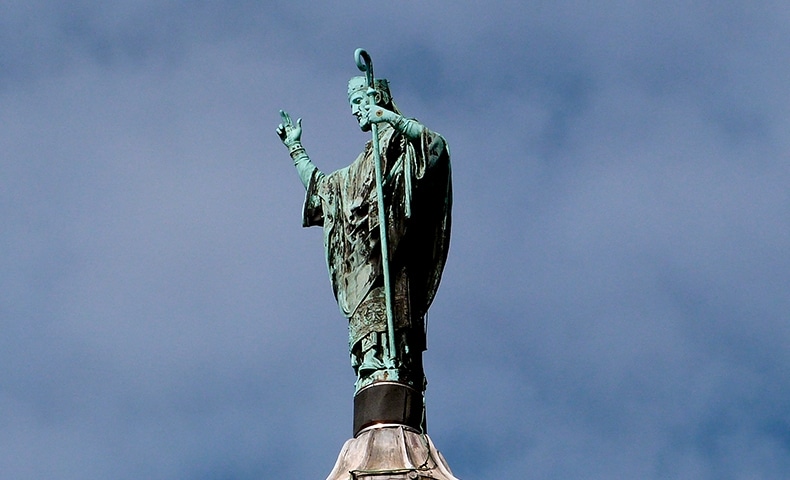
Image: Statue of Saint Martin of Tours on the dome of the Basilica of Saint Martin of Tours | photo by ZohaStel
Saint of the day for november 11, (c. 316 – november 8, 397).
Saint Martin of Tours’ Story
A conscientious objector who wanted to be a monk; a monk who was maneuvered into being a bishop; a bishop who fought paganism as well as pleaded for mercy to heretics—such was Martin of Tours, one of the most popular of saints and one of the first not to be a martyr.
Born of pagan parents in what is now Hungary, and raised in Italy, this son of a veteran was forced at the age of 15 to serve in the army. Martin became a Christian catechumen and was baptized when he was 18. It was said that he lived more like a monk than a soldier. At 23, he refused a war bonus and told his commander: “I have served you as a soldier; now let me serve Christ. Give the bounty to those who are going to fight. But I am a soldier of Christ and it is not lawful for me to fight.” After great difficulties, he was discharged and went to be a disciple of Hilary of Poitiers.
He was ordained an exorcist and worked with great zeal against the Arians. Martin became a monk, living first at Milan and later on a small island. When Hilary was restored to his see following his exile, Martin returned to France and established what may have been the first French monastery near Poitiers. He lived there for 10 years, forming his disciples and preaching throughout the countryside.
The people of Tours demanded that he become their bishop. Martin was drawn to that city by a ruse—the need of a sick person—and was brought to the church, where he reluctantly allowed himself to be consecrated bishop. Some of the consecrating bishops thought his rumpled appearance and unkempt hair indicated that he was not dignified enough for the office.
Along with Saint Ambrose, Martin rejected Bishop Ithacius’s principle of putting heretics to death—as well as the intrusion of the emperor into such matters. He prevailed upon the emperor to spare the life of the heretic Priscillian. For his efforts, Martin was accused of the same heresy, and Priscillian was executed after all. Martin then pleaded for a cessation of the persecution of Priscillian’s followers in Spain. He still felt he could cooperate with Ithacius in other areas, but afterwards his conscience troubled him about this decision.
As death approached, Martin’s followers begged him not to leave them. He prayed, “Lord, if your people still need me, I do not refuse the work. Your will be done.”
Martin’s worry about cooperation with evil reminds us that almost nothing is either all black or all white. The saints are not creatures of another world: They face the same perplexing decisions that we do. Any decision of conscience always involves some risk. If we choose to go north, we may never know what would have happened had we gone east, west, or south. A hyper-cautious withdrawal from all perplexing situations is not the virtue of prudence; it is in fact, a bad decision, for “not to decide is to decide.”
Saint Martin of Tours is a Patron Saint of:
Horses Soldiers South Africa

Sign Up for Our Daily Newsletter
Includes Saint of the Day, Minute Meditations, and Pause + Pray.

Our Mission
- Phone: (513) 241-5615
- Address: 28 W. Liberty St. Cincinnati, OH 45202
Writer’s Guidelines Privacy Policy Post a Prayer Request Donor Portal Our Mission
Recent Articles
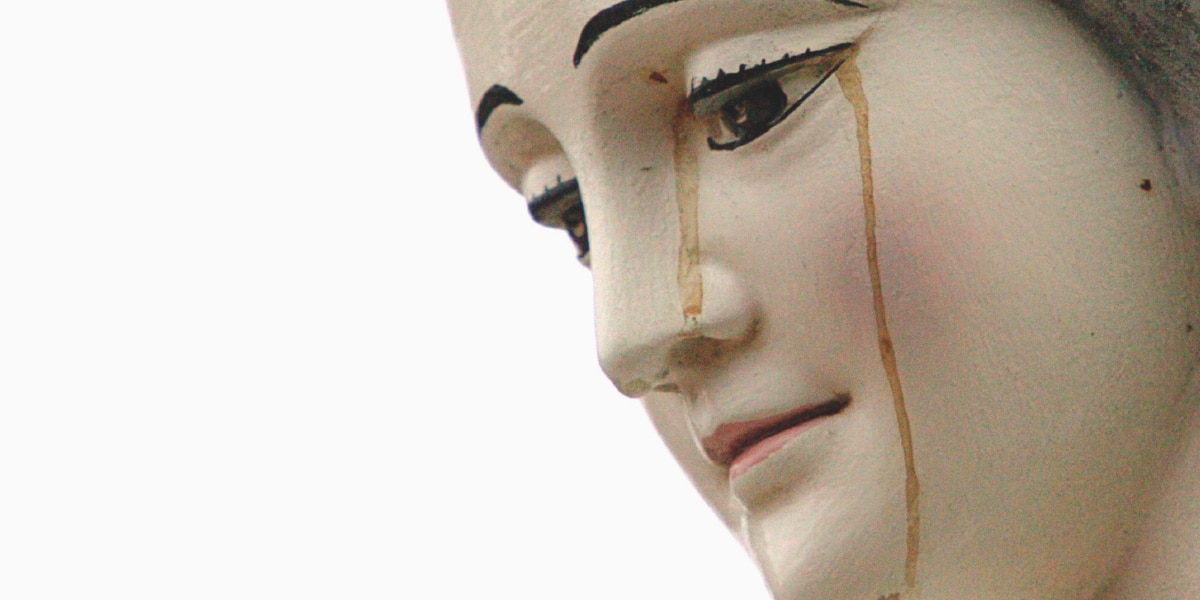
Discerning Supernatural Phenomena
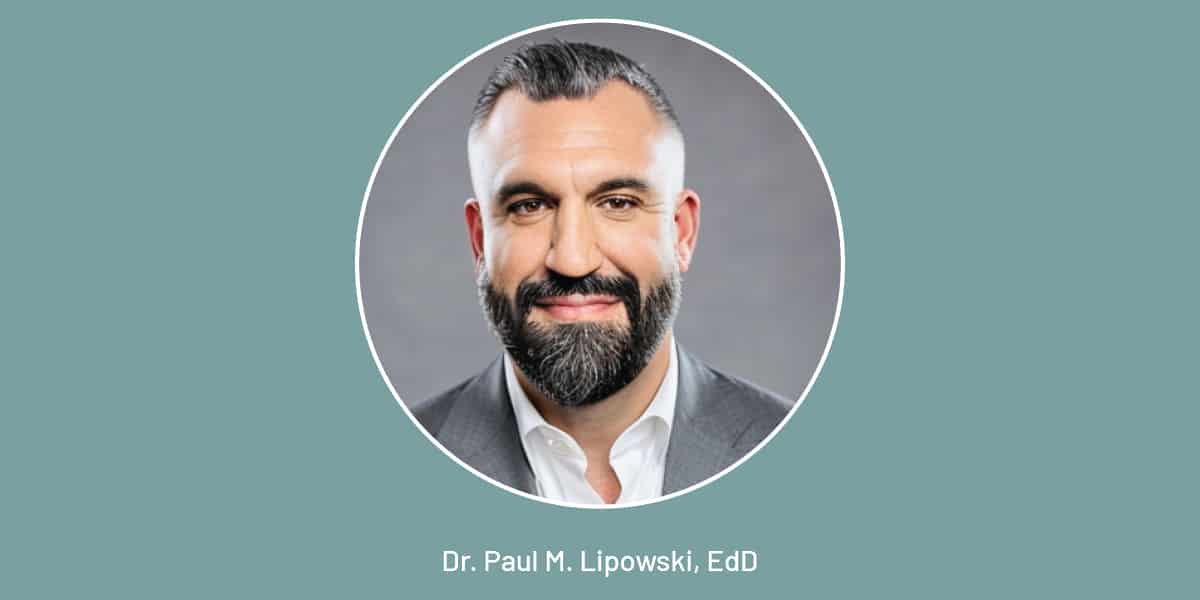
Dr. Paul M. Lipowski, EdD

Olympic bell will ring inside newly rebuilt Notre Dame Cathedral during every Mass

Waiting for Inspiration

Creation Never Hurries

- Find Your Educational Consultant
- Review Our Catalogs
- Catholic Resources
- Saints Stories for All Ages
Saint Martin of Tours
Feast day november 11.
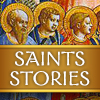
One wintry day, young Martin, soldier and catechumen, met a shivering beggar in the street. He cut his cape in two, giving half to the man. That night in a dream St. Martin saw Jesus wearing it and heard him say, “Martin is still only a catechumen, but has covered me with this garment.” Stunned, soon afterward Martin presented himself for baptism.
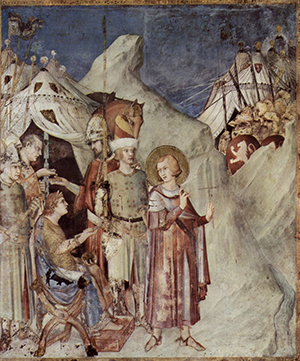
Martin’s father, a Roman tribune, had arranged for his son’s conscription into the army at age 15. So Martin performed military service until he decided that it contradicted his Christian commitment. Sulpicius Severus, the saint’s first biographer, described the day that Martin became the first Christian conscientious objector:
. . . The barbarians were invading the Gallic provinces. Assembling an army at the city of the Vangiones, Emperor Julian prepared to distribute a bonus to his troops. The men were called up in the customary manner, one by one, until Martin’s turn came. He recognized that moment as a suitable time to ask for his discharge, and he did not think it would be honest for him to accept the bonus when he did not intend to fight. “I have fought for you up to this point,” he said to Caesar. “Now let me fight for God. As for your bonus, let someone who is going to join the battle receive it. I am a soldier of Christ: combat is not permitted me.”
Julian exploded with rage and threatened Martin, calling him a coward.
“If my act is set down to cowardice rather than to faith,” he said, “I shall stand unarmed tomorrow before our lines. In the name of the Lord Jesus and protected only by the sign of the cross, without shield or helmet, I shall penetrate the enemy’s ranks and not be afraid.”
The next day, the enemy sent an embassy to sue for peace, handing over themselves and all that was theirs. From this can anyone doubt that the victory was due to the blessed man—a grace granted to prevent his being sent unarmed into combat?
As there was now no war to fight, Martin got his discharge.
Martin was renowned as a miracle worker, performing many cures and even raising a dead man. Once, for example, he healed St. Paulinus of Nola’s diseased eye by touching it lightly with a fine paintbrush. Martin died on November 11, 397. Because of his reputation, he became one of the most admired saints of the Middle Ages.

from Voices of the Saints , by Bert Ghezzi
Image credit: St Martin Leaves the Life of Chivalry and Recounces the Army by Simone Martini, 1326. Public Domain via Wikimedia.
This Week's Stories
Saint clare, saint jane frances de chantal, saints pontian and hypolytus, father kolbe, like jesus, offered himself, assumption of mary, saint stephen of hungary.

St. Martin of Tours
Born: 316 AD
Died: November 8, 397 AD
Feast Day : November 11
Patron of: France
Up until the fifth century, Christians weren’t interested in calling you a saint unless you ended your life in the lion’s mouth, on the gridiron, or shot full of arrows. Martyrdom was where it was at.
Saint Martin of Tours was the first fellow to change all that.
Born in 315, Marin of Tours was the son of an officer in the Roman army and therefore was to enter the army himself, despite his desire to become a hermit. His father was none too pleased with Martin’s leanings toward Christianityt, and doubtless through the years in the army would knock some sense into his son. Martin ended up in the emperor’s elite cavalry corps, where he got two horses, a servant, and a double food ration. He gave away most of the food and he waited on his own servant, to the amusement of his fellow soldiers. He also got a beautiful white cloak lined with lambskin. This was the cloak which, on a frigid night near the city gate, he split with a naked beggar. That night in a dream he saw Jesus wearing the halved cloak and saying “Look, Martin has given me half his cloak, and he is not even baptized!” As a consequence, Martin “flew to be baptized,” reports his biographer.
Two years later, when a barbarian invasion threatened Gaul, Marin refused to enter the battle with his fellow soldiers. He stood before the emperor and asked to resign his commission: “ I am a soldier of Christ, and it is not lawful of me to fight.” When the emperor accused him of cowardice, Martin retorted that he would stand unarmed at the front of the battle and advance alone against the enemy in the name of Christ. He was thrown into prison where, after a night of prayer, he heard the news that the barbarians had asked for peace.
Because of his brave refusal to fight, the peace organization Pax Christi honors Marin of Tours each year as the “conscientious objector saint,” and the Catholic bishops held him up as an example of Christian nonviolence in their 1983 peace pastoral.
When Martin was discharged from the army, he finally fulfilled his dream of becoming a hermit. He lived in happy solitude with a community of hermits who gathered around him for the next ten years. But fame caught up with him at last. In 371 the people of Tours, well aware of Martin’s holiness, demanded him for their bishop. Some of the neighboring bishops thought tours would be better off with a bishop who could do a pair of cufflinks proud- not the unkempt and shabby Martin.
But the people prevailed, much to Martin’s dismay. They invented a ruse to get him into the city, where they forced him to accept the office of bishop.
Unable to tolerate the interruptions of life in the city, Martin soon moved to a cave on the outskirts of town, where he drew more monks about him. Despite his love of solitude, he faithfully visited his diocese during the year, splitting the district up into smaller areas that he christened “parishes.” Martin, the uncle of Saint Patrick, died at 80 and was the first non martyr to be called a saint by the young Christian church.
–Catherine O’Connell-Cahill
Originally published in Salt magazine, ©Claretian Publications.
Image: Wikimedia Commons
What’s trending

What is the prophecy of St. Malachy?

Seeking community, some Catholics rethink the nuclear family

Who is Sophia in the Bible?


A reflection for the twenty-first Sunday in Ordinary Time

National Today
- Arts & Entertainment
- Food & Beverage
- Relationships
- Special Interest
Gift Guides
Got an idea for a holiday send it to us.

St. Martin’s Day – November 11, 2024
St. Martin’s Day, observed on November 11, is the feast day of Saint Martin of Tours, a baptized Roman soldier who became the bishop of a French town. He’s known for cutting his cloak in half to share it with a beggar during a snowstorm. On the same night, he dreamed of Jesus, dressed in a half-cloak, saying to angels, “Here is Martin, the Roman soldier who is now baptized; he has clothed me.” Saint Martin died on November 8, 397, and was interred three days later. His feast day is also known as the Feast of Saint Martin, Martinmas, Old Halloween, or Old Hallowmas Eve,
History of St. Martin’s Day
St. Martin’s Day began in France and proliferated to the Low Countries — the British Isles, Galicia, Germany, Scandinavia, and Eastern Europe. Also known as Martinmas, it is the day when Martin is honored in Mass and marks the beginning of natural winter in the agricultural calendar and the end of autumn in the economic calendar. At this time, plenty of brewed beer and wine becomes available, signaling the end of winter preparations, including animal butchering. Just as during Michaelmas on September 29, devotees eat goose to mark the occasion. The feast is similar to the American Thanksgiving as it celebrates the earth providing for humans.
Martinmas celebrations in some countries begin on the 11th minute of the 11th hour of the 11th day of the 11th month — or at 11:11 a.m. on November 11. Others start the celebrations on St. Martin’s Eve on November 10. In the sixth century, Church councils began requiring fasting through the 56 days, except Saturdays and Sundays, between Saint Martin’s Day and the Epiphany on January 6. This fasting period was known as ‘Quadragesima Sancti Martini,’ or Saint Martin’s Lent, and was similar to the 40 days of fasting during Lent. It was rarely observed before it evolved into the current Advent practice.
Saint Martin’s Day now often involves feasts, dances, and bonfires. After dark, children carry lanterns through the streets, singing songs that earn them candy rewards.
St. Martin’s Day timeline
Spanish forces seize control of Saint Martin from the Dutch, driving most or all of the colonists off the island.
France and the Netherlands sign the Treaty of Concordia, dividing the island between them.
When the Netherlands becomes a puppet state of the French Empire, the French take control of the entire island.
Hurricane Irma causes severe damage, and many residents are left without necessities.
St. Martin’s Day FAQ s
Why is st. martin’s day celebrated.
The feast honors Saint Martin’s life and the end of the agricultural year and harvest.
Why are there lanterns on St. Martin’s Day?
It is typical for children to make lanterns and participate in the procession of paper lanterns in honor of St. Martin. Some speculate that the lanterns are an alternative to the bonfires that characterize Saint Martin’s Day celebrations.
What happens on St. Martin’s Day?
In the parades, young children walk down the streets with candle-lit lanterns and sing Martin songs praising the saint’s generosity.
How to Observe St. Martin’s Day
Participate in the celebrations.
Saint Martin’s Day is celebrated in unique ways across the world. Invite your family to join the colorful procession and carry lanterns made from painted paper.
After the lantern procession, devotees usually eat goose for Saint Martin’s Day dinner. Try the tasty dish to honor the tradition!
Enjoy grapes and local wine
As the patron saint of France, Saint Martin is said to help the spread of wine-making across the country. Taste the local grapes and wine with the locals.
5 Fascinating Facts About Saint Martin
The smallest island.
St. Martin is the world’s smallest inhabited island shared by two countries, France and the Netherlands.
A constitutional country
Sint Maarten, the island’s Dutch side, is one of the four constituent countries comprising the Kingdom of the Netherlands.
A map of Saint Martin
The island of Saint Martin is roughly halved, with the larger French side covering about 20 square miles.
A large population
The Dutch side of the island has a larger population, an estimated 41,177, while the French side has around 32,489 residents.
An island of salt
The island was called ‘Soualiga,’ or “Land of Salt,” because of the salt ponds scattered throughout the island, prompting the French and British to establish salt mining operations.
Why St. Martin’s Day is Important
It celebrates the island.
Saint Martin’s Day commemorates the island’s history and identity. It is known as the world’s smallest island shared by two distinct nations, France and the Netherlands.
It unites two cultures
The island’s two sides have unique qualities. The Dutch south is very urban and modern, whereas the French north has many rugged landscapes and sights for which the tiny island is famous. Despite their differences, both sides celebrate Saint Martin’s Day.
It’s festive
Saint Martin’s Day is celebrated differently across different nations. But most of the celebrations include lantern parades and hearty meals.
St. Martin’s Day dates

Holidays Straight to Your Inbox
Every day is a holiday! Receive fresh holidays directly to your inbox.
- 6,286 Days celebrated
- 18,858 Ways to celebrate
- 1,000,000+ Happy users
- Our Mission
- For Businesses
- For Journalists
- For Influencers
- Submit a Holiday
- Promote an Event
- Work With Us
- Submit an Error
Our Services
- Create A Holiday
- Sponsor A Holiday
- Data Licensing
- National Today Calendar
- Reviews and Gift Guides
Shopping Reviews
- Health & Fitness
- Home & Garden
- By Interest
- By Occasion
- By Recipient
Popular Holidays
- National Girlfriend Day
- Day of the Dead
- National Boyfriend Day
- National Sons Day
- Mexican Independence Day
- Pride Month
- National Best Friends Day
- National Daughter Day
- World Bicycle Day
- National Dog Day
About National Today
We keep track of fun holidays and special moments on the cultural calendar — giving you exciting activities, deals, local events, brand promotions, and other exciting ways to celebrate.
Follow us on

* As an Amazon affiliate, this site earns from qualifying purchases.
Resources by Date
Lesson Plans and Reflections
St. Martin of Tours

Feast Day: November 11
Early life and military service, the cloak incident: a turning point, path to the priesthood and bishopric, connection between st. martin of tours and armistice day.
Mass Readings
Patron Saint of…
Quotes and Social Media Graphics
More Resources
Add a Comment
St. Martin of Tours, a 4th century soldier in the Roman military, holds a significant place in Christian history. Living during a time when Christianity had become legalized in the Roman Empire, Martin’s life and actions exemplify the transformative power of faith. His feast day, celebrated on November 11, provides an opportunity to delve into his life’s story and the lasting impact he has had.
Born in the Roman province of Pannonia around 316 AD, Martin was raised in Italy as the son of a Roman army officer. Despite his pagan upbringing, he felt a strong pull towards Christianity from an early age. However, it was during his time in the military that Martin experienced a life-changing encounter that set him on a path of deep spiritual transformation.
Martin’s story is one of selflessness and compassion. He is best known for the “Cloak Incident,” where he encountered a beggar in need during a bitterly cold winter. Martin, moved by the man’s suffering, cut his own cloak in half and shared it with the beggar. This act of kindness became a turning point in his life, leading him to dedicate himself to the service of God and others.
As we explore the life and legacy of St. Martin of Tours, we will uncover the remarkable journey that took him from military service to the priesthood and eventually to the bishopric. Along the way, we will also discover the miracles attributed to him and the connection between St. Martin of Tours and Armistice Day. Join us as we delve into the inspiring story of this revered saint.
Born in the Roman province of Pannonia around 316 AD, Martin was the son of a Roman army officer and was raised in Italy. Despite his pagan upbringing, Martin felt a pull towards Christianity from an early age. His journey to sainthood interestingly began in the military. As a young soldier in the Roman army, Martin experienced a life-changing encounter that set him on a path to deep spiritual transformation.
During his time in the military, Martin witnessed the harsh realities of war and the suffering it caused. This exposure to violence and the struggles of others deeply affected him and sparked a desire for something greater than the life of a soldier. He began to question the purpose of his existence and sought solace in his faith.
It was during one particular campaign that Martin’s life took a significant turn. While stationed near the city of Amiens, Martin encountered a beggar who was half-naked and freezing in the bitter cold. Moved with compassion, Martin could not ignore the man’s suffering. In a selfless act of kindness, he cut his military cloak in half and shared it with the beggar, providing him with warmth and comfort.
Little did he know that this simple act of kindness would have a profound effect on his life. That night, Martin had a dream in which he saw Jesus wearing the half-cloak he had given away. Jesus said to him, “Martin, who is still but a catechumen, clothed me with this robe.”
This vision was a turning point for Martin. It solidified his commitment to Christianity and led him to be baptized at the age of 18. From that moment on, Martin refused to engage in any further fighting, declaring, “I am the soldier of Christ: it is not lawful for me to fight.” His refusal to continue fighting earned him accusations of cowardice, but Martin remained steadfast in his beliefs.
In a remarkable turn of events, Martin offered to go into battle unarmed as a demonstration of his commitment to non-violence. Surprisingly, the other side agreed to a truce before the battle began, and Martin was released from his military service.
The Cloak Incident was a pivotal moment in Martin’s life, marking his conversion to Christianity and setting him on a path of spiritual awakening and service to others. It serves as a powerful reminder of the transformative power of compassion and the profound impact one act of kindness can have.
After leaving the army, Martin embarked on a new journey of faith. He became a disciple of St. Hilary of Poitiers, a prominent figure in the Church and a staunch defender against Arianism, a heretical belief that denied the divinity of Christ. Under Hilary’s guidance, Martin’s understanding of the Christian faith deepened, and he became increasingly committed to serving God and others.
Inspired by his newfound devotion, Martin established a monastic community in Ligugé, which is considered the first known monastery in Gaul. This community became a haven for those seeking a life of prayer, contemplation, and service. Martin’s reputation for holiness and his ascetic lifestyle attracted many followers, and the monastery flourished under his leadership.
In 371, Martin’s life took another unexpected turn. Despite his reluctance, he was ordained as the Bishop of Tours. This appointment marked a significant milestone in his spiritual journey and a testament to his unwavering commitment to the Church. As bishop, Martin continued to live a life of simplicity and humility, often choosing to reside among the poor and in isolation.
Martin’s path to the priesthood and bishopric exemplifies his unwavering dedication to God and his willingness to serve others. His journey from soldier to monk to bishop showcases his deep faith and the transformative power of his spiritual awakening. Martin’s life serves as an inspiration to all, reminding us of the importance of following our calling and living a life of selflessness and devotion.
Miracles were a significant aspect of St. Martin of Tours’ life, showcasing his deep faith and the power of God working through him. One of the most notable miracles attributed to Martin was the raising of a catechumen from the dead. This miraculous event occurred when Martin encountered a grieving mother whose son had passed away. Moved by compassion, Martin prayed fervently for the young man’s life to be restored. Miraculously, the young man came back to life, a testament to Martin’s unwavering faith and the divine intervention he experienced.
In addition to raising the dead, Martin was also known for his ability to cure the sick. Countless individuals sought his intercession and experienced healing through his prayers. Martin’s commitment to serving the poor and his strong stance against heresy made him a revered figure in the Christian community. His miracles served as a testament to his holiness and the power of God working through him.
These miracles not only brought physical healing but also inspired faith and hope in those who witnessed or heard about them. They served as a reminder of God’s presence and the transformative power of faith. Martin’s miracles continue to inspire believers today, reminding us of the extraordinary ways in which God can work through ordinary individuals who are dedicated to serving Him and others.
St. Martin of Tours’ connection to Armistice Day is rooted in his love of peace and his role as the patron saint of soldiers. His feast day, which is celebrated on November 11th, became a traditional day to end conflicts. This date holds significant historical importance as it marks the end of World War I with the signing of the armistice on November 11, 1918.
Armistice Day was initially established to commemorate the cessation of hostilities on the Western Front, bringing an end to the devastating war. It was a day of remembrance and reflection, honoring the sacrifices made by soldiers and civilians alike. St. Martin’s feast day, coinciding with this momentous occasion, became intertwined with the commemoration of peace and the end of conflict.
Over time, Armistice Day evolved into Veteran’s Day in the United States, expanding its focus to honor all military veterans who have served their country. However, the connection between St. Martin of Tours and Armistice Day remains significant, as his legacy as a soldier-turned-saint and his dedication to promoting peace continue to inspire and resonate with those who commemorate this day.
By celebrating St. Martin’s feast day on November 11th, we not only honor his life and contributions but also pay tribute to the enduring pursuit of peace and the sacrifices made by those who have served in the military. It serves as a reminder of the importance of peace and the ongoing need to strive for harmony in our world.
Patron Saint of …
St. Martin of Tours is the patron saint of conscientious objectors, soldiers, tailors, the poor, and winemakers.
Daily Mass Readings for the Memorial of Saint Martin of Tours, Bishop
In addition to the suggested readings below, the readings may also be taken from the weekday readings, the Common of Pastors , or the Common of Holy Men and Women (for religious).
- First Reading – Isaiah 61:1-3 : The Lord has anointed me to bring good news to the afflicted, liberty to captives, and comfort to mourners, marking a time of divine favor and healing.
- Responsorial Psalm – Psalm 89 : I celebrate the Lord’s enduring kindness and faithfulness, His covenant with David, ensuring his lineage and strength, symbolizing God’s unending mercy and protection.
- Gospel – Matthew 25:31-40 : Jesus described His return in glory, where He, like a shepherd, will separate people as sheep from goats. The righteous, placed on His right, will be blessed and inherit the kingdom for their acts of kindness to the needy. He will reveal that in serving the least of society, they served Him, underscoring the importance of compassion and service in His eyes.

If we do not want to live life poorly, let us ask for the grace to see Jesus in the poor, to serve Jesus in the poor. Pope Francis
Frequently Asked Questions
What date Is the Feast of Saint Martin of Tours?
It is observed annually on November 11.
What are the Mass readings for the Memorial of Saint Martin of Tours, Bishop?
First Reading – Isaiah 61:1-3 : Anointed Mission Responsorial Psalm – Psalm 89 : Eternal Covenant Gospel – Matthew 25:31-40 : The Final Judgment
Who was St. Martin of Tours?
St. Martin of Tours was a Roman soldier who laid down his arms when he became a Christian. He later became a monk and a bishop.
What is the significance of St. Martin of Tours and the Cloak Incident?
The Cloak Incident is a famous event in the life of St. Martin of Tours. It symbolizes his selflessness and willingness to give to those in need. By cutting his cloak in half to share with a beggar, he demonstrated the Christian virtue of generosity.
How did St. Martin of Tours become a saint?
St. Martin’s reputation for holiness and his acts of charity led to his recognition as a saint. His selfless devotion to serving others and his unwavering commitment to the faith made him an inspiration to many.
What is the connection between St. Martin of Tours and Armistice Day?
St. Martin of Tours is linked to Armistice Day due to his reputation as a peace-lover and his status as the patron saint of soldiers. His feast day on November 11th was traditionally seen as a suitable time to stop wars. This date is also historically important because it is the day World War I ended with the signing of the armistice on November 11, 1918.
What miracles are associated with St. Martin of Tours?
St. Martin of Tours is said to have performed numerous miracles during his lifetime. Some of the most well-known miracles include healing the sick, raising the dead, and calming storms.
Who is St. Martin of Tours the patron saint of?
What is the connection between St. Martin of Tours and Veteran’s Day?
St. Martin’s love of peace and his role as the patron saint of soldiers made his feast day a traditional day to end conflicts. Armistice Day, which brought an end to the fighting of World War I, took place on November 11, 1918. The annual observance of Armistice Day eventually became Veteran’s Day in the United States. So there is a real connection between St. Martin of Tours’ feast day and the observance of Veteran’s Day.
How can we be inspired by St. Martin of Tours in our daily lives?
St. Martin of Tours serves as a powerful example of love, mercy, and forgiveness. We can be inspired by his selflessness and willingness to serve others. By following in his footsteps, we can make a positive impact on the lives of those around us and bring the light of Christ to a world in need.
What is the legacy of St. Martin of Tours?
The legacy of St. Martin of Tours is one of compassion, love, and selflessness. His dedication to the faith and his unwavering commitment to serving others continue to inspire people to live out their faith with a generous heart and a humble spirit.
What can we learn from St. Martin of Tours?
St. Martin of Tours teaches us the importance of selflessness, generosity, and service to others. His life serves as a reminder that true greatness lies in serving others and putting their needs before our own. We can learn from his example and strive to live out our faith with compassion, love, and selflessness.
How can St. Martin of Tours inspire us today?
St. Martin of Tours continues to inspire us today through his acts of charity and his unwavering commitment to the faith. His example challenges us to examine our own lives and consider how we can better serve others and live out our faith in a meaningful way.
Throughout his life, St. Martin exemplified the virtues of love, mercy, and forgiveness. He showed us that true greatness lies in serving others and putting their needs before our own. His famous act of cutting his cloak in half to share with a beggar symbolizes his selflessness and willingness to give to those in need. This act of charity not only provided warmth to the beggar but also served as a powerful example of the Christian virtue of generosity.
St. Martin’s life serves as a reminder that we are called to be the hands and feet of Christ in the world. His dedication to the faith and his unwavering commitment to serving others inspire us to live out our faith with a generous heart and a humble spirit. By following in his footsteps, we can make a positive impact on the lives of those around us and bring the light of Christ to a world in need.
As we celebrate St. Martin’s feast day, let us be inspired by his example to live out our faith with compassion, love, and selflessness. May his enduring inspiration continue to guide us in our journey of faith and inspire us to make a difference in the world. St. Martin of Tours, pray for us.
Join our email list to receive weekly emails with Catholic reflections and more.
Leave a Reply Cancel reply
Your email address will not be published. Required fields are marked *
Save my name, email, and website in this browser for the next time I comment.
Saint Martin of Tours
- Short, concise biography of Saint Martin of Tours
- History, Life, Biography, Facts and Information about Saint Martin of Tours
- Fast, concise facts and information
- Date of Birth and Death
- Important Dates surrounding the life of Saint Martin of Tours
- Life History, Story, Biography, Myths and Legends
- Description / Title of the Saint : Bishop
- Memorial Day / Feast Day of Saint Martin of Tours: November 11
- Date of Death: Saint Martin of Tours died 383
- Books, Movies & TV
- Pope Francis
- Bible Study
- Mary & The Saints
- Holidays & Holy Days
- Mass & Sacraments
- Science & Discovery
- Homeschooling
- Marriage & Family
- Parish Life
- Prayers & Devotionals
- Grief & Loss
- Personal Reflections
- Writer Login
- Follow us on Facebook
- Follow us on Twitter

Saint Martin of Tours: A Life of Charity and Devotion

Saint Martin of Tours (316-397 AD) is one of the most beloved and venerated saints in the Roman Catholic Church. Born in the late fourth century in what is now Hungary, Martin was a soldier in the Roman army when he converted to Christianity. He is best known for his mercy and humility, and his acts of charity and kindness.
Saint Martin is the patron saint of beggars, drunkards, horses, riders, soldiers and the poor. He is also the patron saint of France, where he is widely venerated.
He was the son of a Roman army officer and it is said that he was raised a Christian. At the age of 15 Martin joined the Roman army, and while on a campaign in what is now France he was said to have encountered a beggar who was half-naked in the cold. Martin, moved by the sight, took off his own cloak and cut it in half to give to the beggar. That night, legend has it that Martin had a dream in which Jesus was wearing the half-cloak he had given away.
Martin was a skilled horseman and was said to have been able to stand on his horse while galloping it. He was said to have been able to calm wild horses.
Martin is known for his devotion to the poor and his efforts to spread the gospel. He was known for his miracles and was said to have raised the dead, cast out demons and healed the sick. After leaving the military, he became a monk and eventually a bishop, using his position to further the cause of the poor and to spread the gospel.
Saint Martin was canonized by the Catholic Church on December 25th, 1297.
Saint Martin's feast day is celebrated on November 11th, which is also Armistice Day in many countries. On this day, many people light candles, say prayers and attend mass in his honor. In addition to his feast day, his burial place, the Basilica of Saint Martin in Tours, France, is an important pilgrimage site and many people visit it each year to pray and seek blessings.
In summary, Saint Martin of Tours is a beloved saint who is revered for his charity, his miracles and his devotion to the poor. He is a patron of many groups and his legacy continues to inspire people to this day. Whether you are a soldier, a beggar, a rider or simply someone in need, Saint Martin is a powerful intercessor and a true friend to those who seek his help.
Recommended Stories
More stories by :.

The Life of St. Patrick
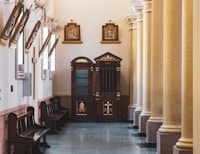
Saint John Vianney: The Cure of Ars and Patron Saint of Parish Priests

Pope Saint John XXII: A Champion of the Catholic Church

Saint Nicodemus: A Life of Faith and Devotion in Orthodox Christianity
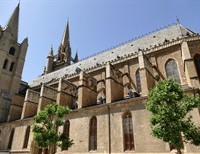
Pope Francis Receives Fr. John Connor of Legionaries of Christ in Private Audience

BOOK GIVEAWAY: "Love and Care for the Marginalized - 40 Meditations"

Utah's New Law Could Help Reduce Abortion

Saint Ignatius of Antioch: An Inspiring Figure of the Early Christian Church

Catholic365.com is a Catholic-focused article and information portal from Catholic writers and bloggers who write about things Catholics are interested in, with 3 main categories - Faith, Life and What's Going On, from a perspective consistent with the Magisterium of the Catholic Church. We strive to spread the word of God and the Catholic faith by highlighting both the articles and the writers through internet and social marketing campaigns. Our goal is to engage and support the Catholic faithful to evangelize to all Catholics using modern technology. Our mission originated with Pope Saint John Paul II's call to Catholics for a "New Evangelization".


- Catholicism
- Religious Catalogue
- Give Monthly
- 1-800-447-3986
- [email protected]
- See of Peter
- Daily Mass and Readings
- Seasons and Feast Days
- Traditional Latin Mass
- Prayer Requests
- EWTN News Nightly
- EWTN Pro-Life Weekly
- EWTN News In Depth
- The World Over
- National Catholic Register
- Catholic News Agency
- Weekly Schedule
- Channel Finder
- Listen Live
- Audio Archive
- Monthly Schedules
- Podcast Central
- Galaxy 33 Transmission Plan
- SW Frequency Guide
- SW Monitoring Form
- Frequently Asked Questions
- EWTN Religious Catalogue
- My Giving Account
- Ways to Give
- Mother Angelica
- Online Learning Series
- EWTN Everywhere
- Media Missionaries
- Privacy Policy
- International Satellite Feeds
St. Martin, Confessor, Bishop of Tours

ST MARTIN, CONFESSOR, BISHOP OF TOURS A.D. 397
Feast: November 11
[For the history of St. Martin we are chiefly indebted to his illustrious disciple St. Sulpicius Severus who, in an elegant and classical style, wrote his life some time before his death.]
The great St. Martin, the glory of Gaul and the light of the Western church in the fourth age, was a native of Sabaria, a town of Upper Pannonia, the ruins of which appear upon the river Gunez, in Lower Hungary, two leagues from Sarwar, upon the Raab, near the confines of Austria and Stiria. St. Gregory of Tours places his birth in the year 316 or before Easter in 317, the eleventh of Constantine the Great. His parents carried him with them in his infancy to Pavia, in Italy, whither they removed, and the saint had his education in that city. His father was an officer in the army. Our saint from his infancy seemed animated with the spirit of God, and to have no relish for anything but for his service, though his parents were idolaters. At ten years of age he made his way to the church against the will of his parents, and desired to be enrolled amongst the catechumens. His request was granted, and he assisted as often as possible at the instructions that were given to such at the church; by which he conceived so ardent a love of God that at twelve years of age he was for retiring into the desert, and would have done it had not the tenderness of his age hindered him. His heart, however, was always set upon the church and monasteries. An imperial order being issued to oblige the sons of veteran officers and soldiers to bear arms, the saint's own father, who very much desired that his son should follow that profession, discovered him, and at fifteen years of age he was entered in the cavalry. He contented himself with one servant, and him he treated as if he were his equal; they ate together, and the master frequently performed for him the lowest offices. All the time he remained in the army he kept himself free from those vices which too frequently sully and degrade that profession and, by his virtue, goodness, and charity, gained the love and esteem of all his companions. He was humble and patient above what human nature seemed capable of, though he was not yet baptized. He comforted all those that suffered affliction and relieved the distressed, reserving to himself out of his pay only what was sufficient for his daily support.
Of his compassion and charity St. Sulpicius has recorded the following illustrious example. One day, in the midst of a very hard winter and severe frost, when many perished with cold, as he was marching with other officers and soldiers, he met at the gate of the city of Amiens a poor man, almost naked, trembling and shaking for cold, and begging alms of those that passed by. Martin, seeing those that went before him take no notice of this miserable object, thought he was reserved for himself. By his charities to others he had nothing left but his arms and clothes upon his back; when, drawing his sword, he cut his cloak in two pieces, gave one to the beggar, and wrapped himself in the other half. Some of the bystanders laughed at the figure he made in that dress, whilst others were ashamed not to have relieved the poor man. In the following night St. Martin saw in his sleep Jesus Christ dressed in that half of the garment which he had given away, and was bid to look at it well and asked whether he knew it. He then heard Jesus say, "Martin, yet a catechumen, has clothed me with this garment." This vision inspired the saint with fresh ardour, and determined him speedily to receive baptism, which he did in the eighteenth year of his age, but still continued almost two years in the army at the request of his tribune, with whom he lived in the most intimate friendship, and who promised to renounce the world when the term of the service and commission in which he was then employed should be elapsed. During this interval Martin was so entirely taken up with the obligations of his baptism that he had little more than the name of a soldier, and expressed much impatience at being detained one moment from devoting himself solely to the divine service. Upon an irruption which the Germans made into Gaul, the troops were assembled to march against them and a donative was distributed amongst the soldiers. Martin thought it would be ungenerous and unjust to receive the donative when he had thoughts of quitting the service. He therefore begged that his donative might be bestowed on some other person, and asked his dismission that he might give himself up totally to the service of Christ. He was told that it was for fear of the battle that was expected next day that he desired his dismission. Martin, with surprising intrepidity, offered to be placed in the front without arms, saying, "In the name of the Lord Jesus, and protected not by a helmet and buckler, but by the sign of the cross, I will thrust myself into the thickest squadrons of the enemy without fear." That night the barbarians demanded and obtained peace; upon which Martin easily procured leave to retire, after having served in the army about five years according to the most probable account.
St. Martin, having quitted the camp, went to St. Hilary, who had been made Bishop of Poitiers in the year 353 or 354. That great prelate soon became acquainted with the saint's extraordinary merit and, in order to fix him in his diocese, would fain have ordained him deacon, but was not able to overcome his humility and was obliged to be content only to make him exorcist. Martin was very desirous to pay his parents a visit in Pannonia; for which he obtained the leave of St. Hilary, who made him promise he would return to him again. In crossing the Alps he fell into the hands of a company of robbers, and one of them lifted up his sword over his head to kill him; but another held his arm. They admired his modesty and intrepidity and asked him who he was, and whether he was not struck with fear at the sight of a sword lifted up to kill him. He answered that he was a Christian, and that he had never been more calm and secure than under that danger, because he certainly knew that the divine goodness is always most ready to protect us in life or in death, and is never more present to us than in the greatest dangers; but said he was only grieved that they, by the lives which they led, deprived themselves of the mercy of Christ. The robbers listened to him, admired the courage and confidence in God which virtue inspires, and he who had attempted to kill the saint put him in his road, became a Christian, led a penitential religious life in a monastery, and himself afterwards related this circumstance. Martin continued his journey through Milan into Pannonia, and converted his mother and many others; but his father remained in his infidelity. In Illyricum he with so much zeal opposed the Arians who prevailed there without control that he was publicly scourged by them and banished the country. In Italy he heard that the church of Gaul was sorely oppressed by these heretics and St. Hilary banished; upon which melancholy news he chose a retreat near the walls of Milan, where he entered upon a monastic life. Auxentius, the Arian invader of the see of Milan, soon became acquainted with his zeal for the orthodox faith and the council of Nice, and drove him out of that diocese. The saint in this distress fell into the company of a very virtuous priest, with whom he agreed to retire to the little desert island of Gallinaria, upon the coast of Liguria, near Albenga. Here, whilst he lived in great abstinence on roots and wild herbs, he happened unawares to eat a considerable quantity of hellebore, enough to have caused his death if he had not been restored to his health when brought to the last extremity by having recourse to prayer. Understanding, in 360, that St. Hilary was returning to his bishopric, he went to Rome to meet him on his road, and finding there that he was already gone by, speedily followed and overtook him and, being most affectionately received by him, accompanied him to Poitiers. It being Martin's earnest desire to pursue his vocation in holy solitude, St. Hilary gave him a little spot of land called Locociagum, now Luguge, two leagues from the city, where our saint built a monastery which was standing in the eighth century, and seems to have been the first that was erected in Gaul. Amongst others who were received by the saint in this house was a certain catechumen who, shortly after, whilst St. Martin was absent for three days upon business relating to the divine service, fell ill of a fever and died suddenly, beyond all expectation and without baptism. The saint, returning home, found his monks in great affliction and the corpse laid out in order to be buried. Bursting into a flood of tears, he fixed his eyes on the corpse; and feeling in himself a divine impulse to work a miracle, he ordered the rest to go out of the chamber and, like another Eliseus, stretched himself upon the dead body and prayed for some time with great earnestness till, perceiving that it began to revive, he rose up and stood by it, whilst in less than two hours the deceased person began to move his limbs, and at last opened his eyes. Being restored to life, he related how after his departure his soul seemed to be presented before the divine tribunal and sentenced to a dark dungeon, but that two angels represented to the judge that St. Martin poured forth his prayers in her behalf; and that the judge ordered them to restore her to the body and raise it to life. The person was immediately baptized and lived many years. Another time the saint restored to life, in the same manner, a slave of a neighbouring rich man who had hanged himself. These two miracles exceedingly spread his reputation, and in the year 371 he was chosen the third Bishop of Tours and consecrated on the 3rd of July. St. Gatian, who came from Rome about the same time with St. Dionysius of Paris in 250, had first preached the faith there, founded that see, and governed it fifty years, as St. Gregory of Tours affirms. His successor, after the see had been several years vacant, was St. Litorius, upon whose death the people demanded St. Martin for their bishop. A stratagem was made use of to call him to the door of his monastery to give his blessing to a sick person, and he was forcibly conveyed to Tours under a strong guard. Some of the neighbouring bishops, who were called to assist at the election, urged that the meanness of his dress and appearance, and his slovenly air, showed him to be unfit for such a dignity. But such objections were commendations of the servant of God, who was installed in the episcopal chair.
St. Martin in this new dignity continued the same manner of life, retaining the same humility of mind, austerity of life, and meanness of dress. He lived at first in a little cell near the church' but, not being able to endure the interruption which he met with from the many visits he there received, he retired to a monastery which he built two miles from the city, which is the famous abbey of Marmoutier, the most ancient that now subsists in France and belongs to the congregation of St. Maur. The place was then a desert, inclosed by a high steep rock on one side and by the river Loire on the other, and the entrance into it was only by one very narrow passage. The holy bishop had a cell built of wood; several of his monks had cells made in the same manner, but the greater part took up their dwellings in narrow holes, which they dug in the side of the rock; one is still shown in which St. Martin is said to have lodged for some time. He had here in a short time about fourscore monks; amongst them no one had any distinct property; no one was allowed to buy or sell, as was the practice of the greater part of the monks with regard to their work and sustenance. No art or business was permitted amongst them except that of writing, to which only the younger were deputed; the more ancient attended to nothing else but to prayer and spiritual functions. Very rarely any went out of his cell except to the oratory, where they assembled at the hours of public prayer; and they ate all together in the evening, after the hour of the fast. Wine was never afforded to anyone unless sickness required it. Most of them had garments of camel's hair, that is, of coarse camlet, and it was esteemed a crime to wear any soft clothing. There were, nevertheless, many persons of quality amongst them who had been educated in a tender and delicate manner. Many bishops were chosen out of this monastery; for there was not a city which did not desire to have a pastor who had been bred under the discipline of St. Martin. The bishop himself was frequently employed in visiting all the parts of his diocese. Not far from his monastery stood a chapel and an altar, erected by the concession of his predecessors over the tomb of a pretended martyr. The place was much reverenced by the people; but St. Martin, who was not over-credulous, would not go thither to pray, not hearing any assured account of the relics. He asked the eldest of the clergy what they knew of them, and not receiving satisfaction, he went one day to the place with some of his brethren and, standing over the tomb, besought God to show him who was buried there. Then, turning to the left, he saw near him a pale ghost, of a fierce aspect, whom he commanded to speak. The ghost told his name, and it appeared that he had been a robber who was executed for his crimes whom the people had honoured as a martyr. None but St. Martin saw him; the rest only heard his voice. He thereupon caused the altar to be removed and freed the people from this superstition.[1]
The utter extirpation of idolatry out of the diocese of Tours, and all that part of Gaul, was the fruit of the edifying piety, miracles, and zealous labours and instructions of St. Martin. Soon after he had entered upon his episcopal charge, he was obliged (probably on account of the heathenish temples or some such affairs) to repair to the court of Valentinian I, who generally resided in Gaul. This prince, knowing that St. Martin was come to beg of him something in favour of the Christian religion which he had no mind to grant, gave orders that he should not be admitted into the palace. Also his wife Justina, who was a furious Arian, endeavoured to prepossess him against the holy bishop. St. Martin, having attempted in vain twice or thrice to get access, had recourse to his ordinary weapons. He put on hair cloth, covered his head with ashes, abstained from eating and drinking, and prayed day and night. On the seventh day he was ordered by an angel to go boldly to the palace. Accordingly he went thither, found the doors open, and nobody stopping him he went to the emperor who, seeing him at a distance, asked in passion why they had let him in, and would not vouchsafe to rise; but the place where he sat was suddenly all in a flame, which soon forced him to get up, says Sulpicius Severus.[2] Then, finding that he had felt the divine power, he embraced the saint several times, and granted him all that he desired even before he had time to mention his requests. After this he gave him audience several times, often made him eat at his table and, at his departure, offered him great presents, which the saint modestly refused out of love to the poverty he professed. This must have happened before the year 375, in which this emperor died.
St. Martin destroyed many temples of idols and felled several trees that were held as sacred by the pagans. Having demolished a very ancient temple, he would also have cut down a pine that stood near it. The chief priest and other pagans opposed; but at length agreed that they themselves would fell it, upon condition that he who trusted so strongly in the God whom he preached would stand under it where they should place him.
The saint, who was directed in these extraordinary events by a divine inspiration, consented, and suffered himself to be tied to that side of the tree on which it leaned. When it seemed just ready to fall upon him, he made the sign of the cross and it fell on the contrary side. There was not one, in a prodigious multitude of pagans that were present, who did not upon the spot demand the imposition of hands in order to be received amongst the catechumens. His zeal exposed him on many occasions to the hazard of his life. Wherever he destroyed temples, he immediately built churches or monasteries; and continued frequently to perform great miracles. At Triers he cured a maid who was sick of a palsy, and just ready to expire, by putting some oil that was blessed into her mouth. He restored to health a slave who belonged to Tetradius, formerly proconsul, that was possessed with a devil. At Paris, as he entered the gate of the city, followed by a great crowd, he kissed a most loathsome leper and gave him his blessing, and he was forthwith healed. Small threads of the clothes or hair shirt of St. Martin often cured the sick when applied to them. One time the saint, as he was going to Chartres, passed through a village the inhabitants of which were all idolaters, yet they all came out to see him pass by. The holy prelate, seeing this multitude of infidels, was moved with extreme compassion, and with earnest affection lifted up his eyes to heaven. Then he began to preach to them the word of God in the manner that he was accustomed, and sweetly to invite them to eternal salvation with such pathetic words, voice, and energy, that it appeared plainly that it was not he who spoke, but God in him. A woman brought to him at that very time her only son, a child who was dead, and besought him as the friend of God to restore him to life. The saint, judging that this miracle might occasion the conversion of many, made his prayer, and in the presence of all the people restored the child alive to the mother, who was amazed and out of herself for joy. The people who had seen this miracle cried out aloud to heaven, ran to the saint, and cast themselves at his feet, beseeching him to make them catechumens, and to prepare them for baptism. St. Martin rejoiced at the conversion of so many souls to God much more than anyone could have done for the conquest of a kingdom or all temporal advantages. Paulinus, who flourished with so great reputation for sanctity at Nola, being seized with a violent pain in his eye, where a cataract was beginning to be formed, St. Martin touched him with a pencil and he was immediately cured.[3] Many other miracles wrought by St. Martin are related by St. Sulpicius Severus, especially in casting out devils, whom he did not expel with threats and terrors as other exorcists were accustomed to do; but, clothed with rough hair cloth and covered with ashes, he prostrated himself upon the ground, and with the arms of holy prayer subdued them and forced them at length to yield. One day when St. Martin was praying in his cell, the devil came to him environed with light, clothed in royal robes, with a crown of gold and precious stones upon his head, and with a gracious and pleasant countenance told him twice that he was Christ. Humility is the touchstone which discovers the devil's artifices, in all which a spirit of pride reigns. By this the saint, after some pause, discerned the evident marks of the angel of darkness and said to him, "The Lord Jesus said not that he was to come clothed with purple, and crowned and adorned with a diadem. Nor will I ever believe him to be Christ who shall not come in the habit and figure in which Christ suffered, and who shall not bear the marks of the cross in his body." At these words the fiend vanished, and left the cell filled with an intolerable stench.
Whilst St. Martin was employed in making spiritual conquests, and in peaceably propagating the kingdom of Jesus Christ, the western empire was shaken with horrible convulsions. Maximus was proclaimed emperor by the Roman legions in Britain in 383, and, passing into Gaul, was acknowledged by the mutinous soldiery there, made Triers the seat of his empire, and defeated Gratian near Paris, who was betrayed by his own forces and assassinated by Andragathius at Lyons, on the 25th of August in 383. St. Martin happened to go to Triers to intercede with the tyrant in favour of certain persons who were condemned to death for adhering to their late master Gratian. Though St. Martin was Maximus's subject, he discovered the utmost reluctance to communicate with Maximus; and when he was invited to dine at the emperor's table, he refused a long while, saying boldly that he could not eat at the same table with a man who had deprived one emperor of his dominions and another of his life. Maximus protested that he had not accepted of the empire voluntarily, but that it had been forced upon him by the soldiery; that his incredible success seemed to testify the will of God, and that not one of his enemies had perished, except those who lost their lives in the battle. St. Martin at length was prevailed upon to accept the invitation, which gave the emperor the utmost satisfaction, who ordered a great entertainment to be made, and invited the most considerable persons of his court and, among others, his uncle and brother, both counts, and the prefect of the praetorium. The priest who accompanied St. Martin was seated in a most honourable place between two counts and on the same couch; and St. Martin on a low seat near the emperor. In the midst of the entertainment, an officer presented the cup as usual to Maximus, who ordered it to be given to St. Martin, expecting to receive it from his hand; but, when the bishop had drank, he gave it to the priest, as the most worthy person in the company; which action was exceedingly applauded by the emperor and the whole court. The empress, who attended night and day to the bishop's discourses, sat always at his feet upon the ground, and would needs give him an entertainment in her turn, to which she invited the emperor. St. Martin consented with the utmost reluctance, for though he was above seventy years old, he never conversed with women except on necessary spiritual affairs. But he found it unavoidable, as he had several things to petition for; such as the delivery of prisoners, the recalling several that were in banishment, and restoring estates that had been confiscated. The empress herself waited upon him at table in the humble posture of a servant.
Neither St. Ambrose nor St. Martin would communicate with Ithacius or those bishops who held communion with him, because they sought to put heretics to death. We cannot wonder at the offence these saints took at their prosecuting Priscillian in such a manner, when we consider how much the church abhorred the sledding of the blood even of criminals, and never suffered any of her clergy to have any share in such causes. St. Martin continually reproved Ithacius for his conduct, and pressed him to desist from his accusation. He also besought Maximus not to spill the blood of the guilty; saying it was sufficient that they had been declared heretics and excommunicated by the bishops, and that there was no precedent of an ecclesiastical cause being brought before a secular judge. Ithacius, far from hearkening to his advice, presumed to accuse him of this heresy, as he usually did those whose manner of life seemed to him too rigid.
The Ithacians prevailed upon the emperor to send tribunes into Spain with a sovereign power to search out heretics and deprive them of their lives and possessions. No one doubted but many innocent persons would fall undistinguished in this search: for the paleness of a man's countenance or his dress was enough to bring him into suspicion with those people. The day after they had obtained this order, they heard, when they least expected it, that St. Martin was almost got to Triers; for he was obliged to go there very often about affairs of charity. The Ithacians were greatly alarmed at his coming, and when they found that he abstained from their communion, they told the emperor that if the obstinacy of Theognostus was supported by Martin's authority, their reputation would be entirely ruined. Maximus therefore represented mildly to the holy man that the heretics had been justly condemned for their crimes by the imperial judges, not by the bishops. But perceiving that St. Martin was not moved, but urged that the bishops had carried on the prosecutions, Maximus fell into a passion, and going away, gave immediate orders that the persons for whom he came to intercede should be put to death. These were Count Narses and the governor Leucadius, who were obnoxious to Maximus for having adhered to Gratian's party. The holy man had still more at heart to prevent the tribunes being sent into Spain, and this not only for the sake of many Catholics, but also for the heretics, whose lives he was extremely desirous to save His not communicating with the Ithacians was only meant by him to prevent the mischiefs which might arise from the scandal of their unjust deportment; but, as they were not excommunicated, it was no violation of any canon to communicate with them. St. Martin therefore in this extremity ran to the palace again, and promised the emperor to communicate with Ithacius provided he would pardon those unfortunate persons and recall the tribunes which had been sent into Spain. Maximus immediately complied with his demands. The next day being pitched upon by the Ithacians for the ordination of Felix, the newly-elected Bishop of Triers, St. Martin communicated with them upon that occasion, that so many people might be rescued from slaughter. The day following, he left Triers with some remorse or grief for his condescension. But he was comforted by an angel at prayer in the wood near Andethanna, now Echternach, five miles from Triers, who said to him that he had reason to grieve for a condescension which was a misery, but charity rendered it necessary and excusable. St. Sulpicius adds that St. Martin used to tell them with tears in his eyes that, from this time, it cost him more difficulty and longer prayers to cast out devils than formerly. Some weakness, imperfection, or venial sin is often an occasion of a subtraction of sensible devotion or grace till it be recovered by greater humility and compunction: though such subtractions are frequently sent merely for trials.
St. Martin continued his journey to Tours, where he was received as the tutelar angel of his people. In his great age he relaxed nothing of his austerities or of his zealous labours for the salvation of others; and he continued to the end of his life to confirm his doctrine by frequent and wonderful miracles, as we are assured by St. Sulpicius Severus.
St. Martin was above fourscore years old when God was pleased to put a happy end to his labours. Long before his departure he had knowledge of his approaching death, which he clearly foretold to his disciples. Being informed that a scandalous difference had arisen amongst the clergy at Cande, a parish at the extremity of his diocese at the confluence of the Loire and the Vienne, in Touraine, upon the borders of Poitou and Anjou, he went thither to compose the disturbance, attended as usual by a great number of his disciples. Having remained there some time and settled all things to his satisfaction, he was preparing for his return when he was seized with his last sickness, and found, on a sudden, his strength fail him As soon as he was taken ill, he called his religious brethren about him and told them that the time of his departure was come. At this news they all with tears and with one voice said to him, "Father, why do you forsake us? or to whom do you recommend us? The ravening wolves will fall upon your flock. We know you desire to be with Jesus Christ, but your reward is secure; nor will be a whit diminished by being deferred awhile. Have pity on our necessity? who are left amidst great dangers."
The servant of God, moved with their tears, wept also, and prayed thus: "Lord, if I am still necessary to thy people, I refuse no labour. Thy holy will be done." As if he had said, says St. Sulpicius, my soul is unconquered by old age, weakness, or fatigues, and ready to sustain new conflicts if you call me to them. But if you spare my age, and take me to yourself, be the guardian and protector of those souls for which I fear. By these words he showed that he knew not which was dearest to him, either to remain on earth for Christ or to leave the earth for Christ; and has taught us in prayer for temporal things to remit ourselves with perfect resignation and indifference to the divine will, begging that God may direct all things in us and through us to his greater glory. The saint had a fever which lasted some days; notwithstanding which he spent the night in prayer, lying on ashes and hair cloth. His disciples earnestly entreated him that he would suffer them at least to put a little straw under him; but he replied, "It becomes not a Christian to die otherwise than upon ashes. I shall have sinned if I leave you any other example." He continually held up his eyes and hands to heaven, never interrupting his prayer, so that the priest that stood about him begged that he would turn on one side to afford his body a little rest. He answered, "Allow me, my brethren, to look rather towards heaven than upon the earth, that my soul may be directed to take its flight to the Lord to whom it is going." Afterwards, seeing the devil near him, he said, "What cost thou here, cruel beast? Thou shalt find nothing in me. Abraham's bosom is open to receive me." Saying these words he expired on the 8th of November, probably in 397. He died seven months offer St. Ambrose, as St. Gregory of Tours assures us. They who were present wondered at the brightness of his face and whole body, which seemed to them as if it were already glorified.[4] The inhabitants of Poitiers warmly disputed the possession of his body, but the people of Tours carried it off. The whole city came out to meet it; all the country people, and many from neighbouring cities, flocked thither, with about two thousand monks and a great company of virgins. They all melted into tears, though no one doubted of his glory. He was carried with hymns to the place of his interment, which was in a little grove at some distance from the monastery, where certain monks lived in separate cells. The place was then five hundred and thirty paces from the city, as St. Gregory of Tours informs us, though at present it is part of it, and the walls were carried so far as to encompass it in the beginning of the inroads of the Normans. St. Brice, St. Martin's successor, built a chapel over his tomb, and St. Perpetuus, the sixth Bishop of Tours, about the year 470, founded upon that spot the great church and monastery, the saint's sumptuous tomb being placed behind the high altar. The extraordinary devotion which the French and all Europe have expressed to St. Martin, and to this church for the sake of his precious tomb, would furnish matter for a large history. The Huguenots rifled the shrine and scattered the relics of this saint. But this church recovered a bone of his arm and part of his skull.[5] Before this dispersion, certain churches had obtained small portions which they still preserve. The priory of St. Martin's-in-the-Fields, at Paris, is possessed of a part; two of his teeth are shown in St. Martin's, at Tournay. The cathedral at Tours was built by St. Martin in honour of St. Maurice; but since the year 1096 bears the title of St. Gatian's. Its chapter is one of the most illustrious in France; the Bishop of Tours was suffragan to Rouen till he was made a metropolitan. A vial of sacred oil is kept at St. Martin's, with which Henry IV was anointed king, instead of that from Rheims. St. Sulpicius relates that St. Martin sometimes cured distempers by oil which he had blessed, and that this oil was sometimes miraculously increased.[6]
Many miracles wrought at the shrine of St. Martin, or through his intercession, immediately after his happy death, some of which are recounted by St. Gregory of Tours, Fortunatus, and others, excited exceedingly the devotion of the people. Some have imagined that he was the first saint publicly honoured by the church as a confessor; but this is not so much as insinuated by any ancient author; and St. John the Evangelist, St. Thecla, and many others were not properly martyrs, not to mention St. Petronilla, St. Praxedes, and St. Pudentiana. The principal feast of St. Martin is kept On the 11th of November; that of his ordination and the translation of his relics on the 4th of July; that of bringing them back from Auxerre to Tours, called Relatio, on the 13th of December.
The virtue of St. Martin, which was the miracle of the world, was founded in the most profound humility, perfect meekness, and self-denial by which he was dead to himself, in his continual meditation on religious truths, in his love of heavenly things and contempt of the world, to which his heart was crucified: lastly, in the constant union of his soul to God, by the exercise of holy prayer and by the entire resignation of himself to the divine will in all things without reserve.
1 Sulp. Sev. in vit. St. Mart, 6. II, p. 310.
2 Sulp. Sev, Dial. 2, c. 5, p. 456.
3 Sulp. de vita St. Martin, c. 9;
4 St. Sulpic. Sever. Ep. 3, ad Bassulam Socrum Suam, p. 369.
5 See Gervaise, lib. iv. p. 344, 352.
6 St. Sulp. Dial. 3, c. 2, 3.
(Taken from Vol. III of "The Lives or the Fathers, Martyrs and Other Principal Saints" by the Rev. Alban Butler.)

- Join our Mailing List
- Login

- Inspirational
- Encouragement
- Marriage & Family
- Daily Reflections
“Lord, make me an instrument of thy peace. Where there is hatred, let me sow love.” -St. Francis of Assisi
St. Martin of Tours (Feast Day – November 11)
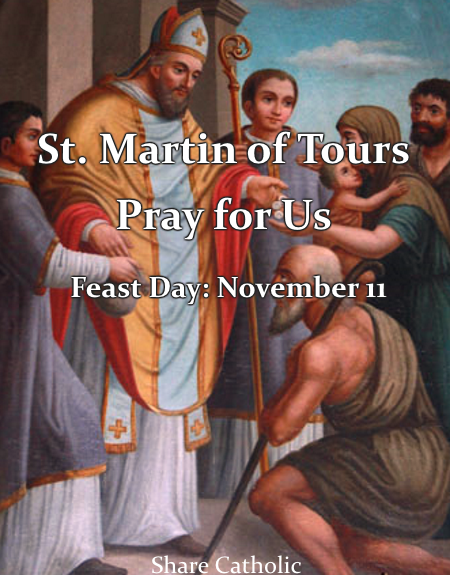
Happy Feast Day of St. Martin of Tours!
St. Martin of Tours was a Bishop of Tours, a shrine in France. He is one of the most popular and recognizable Saints of the Church. He is the Patron Saint of soldiers.
On a trip over the Alps to visit his parents, he was attacked by robbers who not only wanted to steal what he owned but threatened to take his life. Calm and unperturbed, Martin spoke to the robbers about God. One of the robbers was so impressed that he converted and became a law-abiding citizen.
Many miracles have been attributed to him. In one case out of many a father came to him grief stricken that his daughter had never spoken. Martin healed her by asking her to say her father’s name — which she did.

Popular Posts

Connect with Us
- 7562 followers
- 151005 likes
- 3718 followers
ShareCatholic
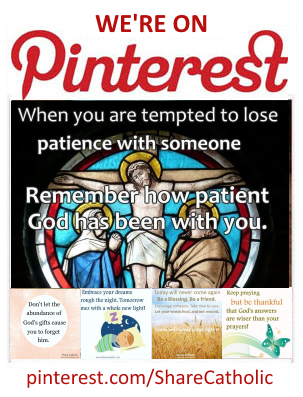
- Daily Reading for Thursday, October ...
- Today's Reading
- The Mysteries of the Rosary
St. Martin of Tours
- Catholic Online
- Saints & Angels

Author and Publisher - Catholic Online Printable Catholic Saints PDFs Shop St. Martin of Tours
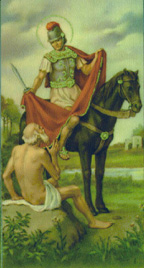
Saint Martin of Tours was born in in Savaria, Pannonia in either the year 316 or 336 AD. That region is what is today the nation of Hungary. His father was a tribune, which is a high-ranking officer in the Imperial Horse Guard. Martin and his family went with his father when he was assigned to a post at Ticinum, in Northern Italy. It is here that Martin would grow up.
Just before Martin was born, Christianity was legalized in the Roman Empire and the bloody persecution of Christians soon came to an end. It was not the official religion of the State, but it could be practiced and proclaimed openly. The Gospel message soon flourished in ancient Rome, transforming the empire. Martin's parents were pagans, but at the age of 10, Martin chose to respond to the call of the Gospel and become a Christian.
At the age of fifteen, Martin was required to follow his father into the cavalry corps of the Roman military. By the time he was 18, Martin is believed to have served in Gaul, and also eventually Milan and Treves. Scholars think he served as part of the emperor's guard.
As a young soldier, Martin encountered a beggar in Amiens. The beggar was unclothed and it was very cold. Martin removed his cloak and with his sword, he cut it in half. He gave this half to the beggar and dressed himself in the remnant. That night, Martin had a vision in which Christ appeared to him. The vision spoke to him, "Martin, a mere catechumen has clothed me." A catechumen is one who is being instructed in the Christian faith. In the early centuries of Christianity, that was a long process of instruction - and Martin was deeply dedicated to it.

Shop Rosaries
About the age of 20, Martin made clear to his superiors that he would no longer fight, following his formed Christian conscience. He refused his pay prior to a battle and announced he would not join in the combat. He became the first recognized conscientious objector in recorded history. His proclamation occurred before a battle near the modern German city of Worms. His superiors accused him of cowardice and ordered that he be imprisoned. Martin offered to demonstrate his sincerity by going into battle unarmed. This was seen as an acceptable alternative to jailing him, but before the battle could occur, the opposing army agreed to a truce and no conflict took place. Martin was subsequently released from military service.
Now out of the military service, Martin could fully dedicate himself to service of Jesus Christ and the Church. He traveled to Tours where he began studying under Hilary of Poitiers, who is now recognized as a doctor of the Church. Martin's studies lasted until Hilary was forced into temporary exile, likely because of his refusal to participate in a political dispute.
Martin then traveled to Italy. According to one account, Martin was confronted by a highwayman and led him to faith in Jesus Christ. Another account tells of Martin confronting the Devil. While on this journey, Martin had a vision which compelled him to return to his mother in Pannonia. He did so and led his own mother to faith in Jesus Christ. Martin attempted to persuade his father to embrace faith in Jesus Christ, but as far as we know, his father refused.
After bringing his mother to the Church, Martin then turned to confronting a growing heresy which was afflicting the faithful and sowing confusion. He became involved in countering the Arian heresy, which denied the divinity of Jesus Christ. The reaction against him was so violent from the Arian leaders that he was compelled to flee. Martin took up residence on an island in the Adriatic where he lived as a hermit for a time.
Martin's teacher Hilary returned to Tours from temporary exile in 361 so Martin traveled there to work and study. Hilary gave Martin a small grant of land where he and his disciples lived.
Martin established a monastery which would be inhabited by the Benedictines. Established in 361, the Liguge Abbey was destroyed during the French Revolution, then reestablished in 1853. The abbey remains to this day. From the site of his abbey, Martin worked to bring people to faith in Jesus Christ and Baptism into His Church in the surrounding areas. He was an extraordinary evangelist.

Supporting FREE Catholic Education with Grass-fed Beef
In 371, the city of Tours needed a new bishop and the people decided to call Martin to the office. Martin did not want the job so the people decided to trick him into the office. The people insisted he was needed to administer to someone sick, so he came out as quickly as he could. He did not even bother to improve his appearance. When he learned it was a trick to make him a bishop, Martin actually tried to hide. He was quickly discovered and the people called him forward to be ordained to the office of Bishop. Even though he did not really want the office, he was ordained - and he became a holy and hardworking Bishop.
As a Bishop Martin established a system of parishes to manage his diocese. He made a point to visit each parish at least once per year. In addition to his appointed rounds, Martin combated paganism, particularly the Druid religion which was still prevalent at the time. He passionately and faithfully proclaimed the Gospel of Jesus Christ and won many to the Christian faith.
Yet, he longed for more prayer and wanted to pursue a monastic life. In the year 372 Martin established an abbey at Marmoutier so he could retreat there and live as a monk with the many disciples he had attracted.
In the following years, a heresy broke out in the church. An aesthetic sect called the Priscillianists after their leader, Priscillian, had developed in Spain and Gaul. The First Council of Saragossa condemned the heresy, but the Priscillians did not change they practices. This prompted one bishop, Ithacius of Ossonoba to petition the Roman Emperor Magnus Maximus to put him to death. Martin was opposed to the sentence of death, and was joined by Bishop Ambrose of Milan in his opposition. Martin traveled to Trier where the Emperor held court. Martin was able to persuade the Emperor to refrain from putting Priscillian and his followers to death. However, after Martin left, Ithacius persuaded the Emperor to change his mind again and Priscillian and his followers were executed in 385.
Martin was so upset by Ithacius, he refused to communicate with his fellow bishop until the Emperor pressured him to resume communicating with his colleague.
Martin died in Candes-Saint-Martin, Gaul in 397.
The Hagiographer Sulpicius Severus, knew Martin personally and wrote about his life. Many miracles and the casting out of demons were attributed to Martin during his lifetime. According to one account, Martin, while trying to win Druids to follow Jesus Christ and renounce their pagan beliefs, was dared to stand in the path of a sacred tree that was being felled. Martin agreed and was missed by the falling pine, although standing right in its path. This was widely seen as miraculous and a symbol that the message he proclaimed about Jesus Christ was true. Many were converted to the Christian faith.

The Battle for Catholic Education - Prevent the Collapse Now!
Veneration of St. Martin became popular in the Middle Ages, and was popular with the Frankish kings.
Saint Martin is the patron of the poor, soldiers, conscientious objectors, tailors, and winemakers. Many locations across Europe have also been placed under his patronage. His feast is on November 11. He commonly appears on horseback and is shown cutting his cloak in half with a sword.
- ← St. Martin Tinh
- St. Martius →
St. Martin of Tours Fun Facts

More Saints
- Trending Saints:
- St. Faustina Kowalska
- St. Francis of Assisi
- St. Michael the Archangel
- Bl. Laura Vicuna

Find Saints
- More Saints & Angels

Light your Free Virtual Prayer Candle: We will pray with you
Join the movement when you sign up below, you don't just join an email list - you're joining an entire movement for free world class catholic education..

- Mysteries of the Rosary Mysteries of the Rosary
- St. Faustina Kowalska St. Faustina Kowalska
- Litany of the Blessed Virgin Mary Litany of the Blessed Virgin Mary
- Saint of the Day for Wednesday, Oct 4th, 2023 Saint of the Day for ...
- Popular Saints Popular Saints
- St. Francis of Assisi St. Francis of Assisi
- Bible Bible
- Female / Women Saints Female / Women Saints
- 7 Morning Prayers you need to get your day started with God 7 Morning Prayers you need to ...
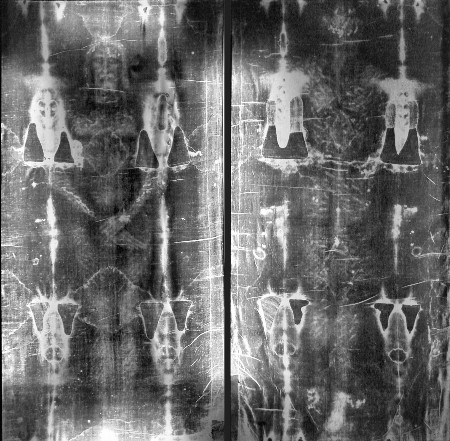
New Shroud of Turin Evidence Links to Enduring Mystery of Christ's Crucifixion
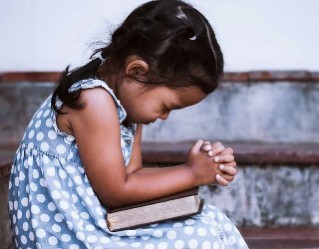
5 Simple Children's Prayers Your Kid Will Love To Learn
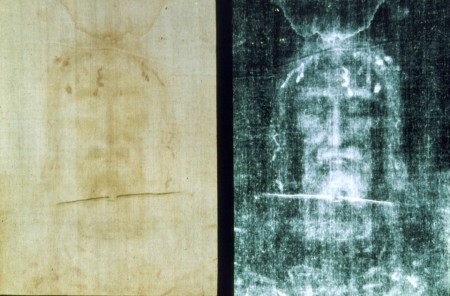
Shroud of Turin: New X-Ray Analysis Reignites Debate on the Burial Cloth of Jesus
Ancient jerusalem quarry unveils new insights into the second temple era and the path of jesus, researchers find shroud of turin dates to time of jesus christ, daily catholic.

- Daily Readings for Thursday, August 22, 2024
- St. Andrew the Scot: Saint of the Day for Thursday, August 22, 2024
- Adoration Prayer : Prayer of the Day for Thursday, August 22, 2024

Enjoy our RCIA class? Pay it Forward
Saints & angels.

- Saints Feast Days
- Female Saints
- Saint of the Day
- Browse Saints
- Popular Saints
- Patron Saints
- Saint Fun Facts
- Martyr Saints

- Mysteries of the Rosary
- Stations of the Cross
- Guide for Confession
- Prayer of the Day
- Browse Prayers
- Popular Prayers
- Holy Rosary
- Sacraments of the Catholic Church
- More Prayers
- Daily Readings
- New Testament
- Old Testament
- Books of the Bible
- Ten Commandments
More of Catholic Online
- Lent & Easter
- Advent & Christmas
- Catholic Encyclopedia
- All of Catholic Online

Secret Archives of the Saints, Subscribe Today
- Privacy Statement
- Terms of Service
Copyright 2024 Catholic Online. All materials contained on this site, whether written, audible or visual are the exclusive property of Catholic Online and are protected under U.S. and International copyright laws, © Copyright 2024 Catholic Online. Any unauthorized use, without prior written consent of Catholic Online is strictly forbidden and prohibited.
Catholic Online is a Project of Your Catholic Voice Foundation, a Not-for-Profit Corporation. Your Catholic Voice Foundation has been granted a recognition of tax exemption under Section 501(c)(3) of the Internal Revenue Code. Federal Tax Identification Number: 81-0596847. Your gift is tax-deductible as allowed by law.
We ask you, humbly: do not scroll away
To all our readers, please don't scroll past this..


IMAGES
COMMENTS
St. Martin of Tours Feast day: Nov 11 On Nov. 11, the Catholic Church honors St. Martin of Tours, who left his post in the Roman army to become a "soldier of Christ" as a monk and later bishop.
Death: 397. Author and Publisher - Catholic Online. Printable Catholic Saints PDFs. Shop St. Martin of Tours. Saint Martin of Tours was born in in Savaria, Pannonia in either the year 316 or 336 AD. That region is what is today the nation of Hungary. His father was a tribune, which is a high-ranking officer in the Imperial Horse Guard.
St. Martin of Tours (born 316, Sabaria, Pannonia [now Szombathely, Hungary]—died November 8, 397, Candes, Gaul [France]; Western feast day, November 11; Eastern feast day November 12) was the patron saint of France, father of monasticism in Gaul, and the first great leader of Western monasticism. Of pagan parentage, Martin chose Christianity ...
St. Martin of Tours died on November 8, 397. His legacy lives on in his feast day, November 11, celebrated in many parts of the Christian world. He is the patron saint of soldiers, horses, riders, geese, and vintners, among other things, due to various legends and tales associated with him.
November 11: Saint Martin of Tours, Bishop—Memorial. 316 or 336-397 Patron Saint of beggars, cavalry, equestrians, geese, horses, innkeepers, Pontifical Swiss Guards, quartermasters, reformed alcoholics, soldiers, tailors, and winemakers ... One day Martin ate a poisonous root by mistake, but through fervent prayer, God healed him.
From the 2014 archives: November 11 in the ecclesiastical calendar marks the Memorial of St. Martin of Tours. For modern American readers, this date doesn’t bring to mind too many Catholic ...
Saint Martin of Tours is a Patron Saint of: Horses. Soldiers. South Africa. Saint Martin of Tours is often depicted as a soldier mounted on a horse sharing his cloak with a poor man. He became a monk and then a bishop, but he never lost his love for the poor. He spent a good deal of energy fighting for the Church, and for mercy toward heretics.
MARTIN OF TOURS. Feast: November 11. Bishop; born at Sabaria (today Steinamanger in German, or Szombathely in Hungarian), Pannonia (Hungary), about 316; died at Candes, Touraine, most probably in 397. In his early years, when his father, a military tribune, was transferred to Pavia in Italy, Martin accompanied him thither, and when he reached ...
Seasons and Feast Days. Library. Prayer Requests. Catholicism. Saints. St. Martin of Tours. St. Martin of Tours. Share. St. Martin, called "the glory of Gaul," was born about the year 316 of pagan parents in Sabaria, Upper Pannonia, a province comprising northern Yugoslavia and western Hungary. ... and three days later was buried at Tours. Two ...
As there was now no war to fight, Martin got his discharge. Martin was renowned as a miracle worker, performing many cures and even raising a dead man. Once, for example, he healed St. Paulinus of Nola's diseased eye by touching it lightly with a fine paintbrush. Martin died on November 11, 397. Because of his reputation, he became one of the ...
St. Martin of Tours. Born: 316 AD. Died: November 8, 397 AD. Feast Day: November 11. Patron of: France. Up until the fifth century, Christians weren't interested in calling you a saint unless you ended your life in the lion's mouth, on the gridiron, or shot full of arrows. Martyrdom was where it was at.
November 11, 2024. St. Martin's Day, observed on November 11, is the feast day of Saint Martin of Tours, a baptized Roman soldier who became the bishop of a French town. He's known for cutting his cloak in half to share it with a beggar during a snowstorm. On the same night, he dreamed of Jesus, dressed in a half-cloak, saying to angels ...
St. Martin of Tours, a 4th century soldier in the Roman military, holds a significant place in Christian history. Living during a time when Christianity had become legalized in the Roman Empire, Martin's life and actions exemplify the transformative power of faith. His feast day, celebrated on November 11, provides an opportunity to delve ...
The Feast Day of Saint Martin of Tours is November 11. The origin of Feast Days: most saints have specially designated feast days and are associated with a specific day of the year and these are referred to as the saint's feast day. The feast days first arose from the very early Christian custom of the annual commemoration of martyrs on the ...
Saint Martin's feast day is celebrated on November 11th, which is also Armistice Day in many countries. On this day, many people light candles, say prayers and attend mass in his honor. In addition to his feast day, his burial place, the Basilica of Saint Martin in Tours, France, is an important pilgrimage site and many people visit it each ...
St. Martin of Tours was a Roman soldier in the fourth century who became a monk and bishop. He is the patron saint of the poor and of soldiers. Many years ago, the feast of St. Martin of Tours was called Martinmas or St. Martin's Day, and was the last day of feasting before the penitential season of Advent. The goose is a common symbol of St ...
Martin Luther was named after St. Martin, as he was baptised on November 11 (St. Martin's Day), 1483, and many older Lutheran congregations are named after St. Martin. Martin of Tours is the patron saint of the U.S. Army Quartermaster Corps , which has a medal in his name.
The cathedral at Tours was built by St. Martin in honour of St. Maurice; but since the year 1096 bears the title of St. Gatian's. Its chapter is one of the most illustrious in France; the Bishop of Tours was suffragan to Rouen till he was made a metropolitan. A vial of sacred oil is kept at St. Martin's, with which Henry IV was anointed king ...
St. Martin of Tours (Feast Day - November 11) Saint of the Day, Saints. Follow @ShareCatholic 5,267 views. Happy Feast Day of St. Martin of Tours! St. Martin of Tours was a Bishop of Tours, a shrine in France. He is one of the most popular and recognizable Saints of the Church. He is the Patron Saint of soldiers.
for the Feast of St. Martin of Tours Bishop November 11. MASS. ENTRANCE ANTIPHON 1 Samuel 2:35 Suscitabo mihi sacerdotem fidelem, qui iuxta cor meum et animam meam faciet, dicit Dominus ... and a day of vindication by our God, to comfort all who mourn; To place on those who mourn in Zion
Today is Saturday, April 6, 2024. St Martin of Tours was the 3rd bishop of Tours in France. He was born in 316 AD in Savaria, (now Szombathely) Hungary. He died on November 8 397 AD in Candes-Saint-Martin, France. We celebrate his feast day on November 11 every year in the Catholic Church. St Martin of Tours, Bishop Biography.
Death: 397. Author and Publisher - Catholic Online. Printable Catholic Saints PDFs. Shop St. Martin of Tours. Saint Martin of Tours was born in in Savaria, Pannonia in either the year 316 or 336 AD. That region is what is today the nation of Hungary. His father was a tribune, which is a high-ranking officer in the Imperial Horse Guard.
Circa 350 AD, St Martin of Tours (c. 316-397), gives half his cloak to the homeless poor. He was a French prelate, founder of the first monastery in Gaul at Liguge, c. 361, and bishop...